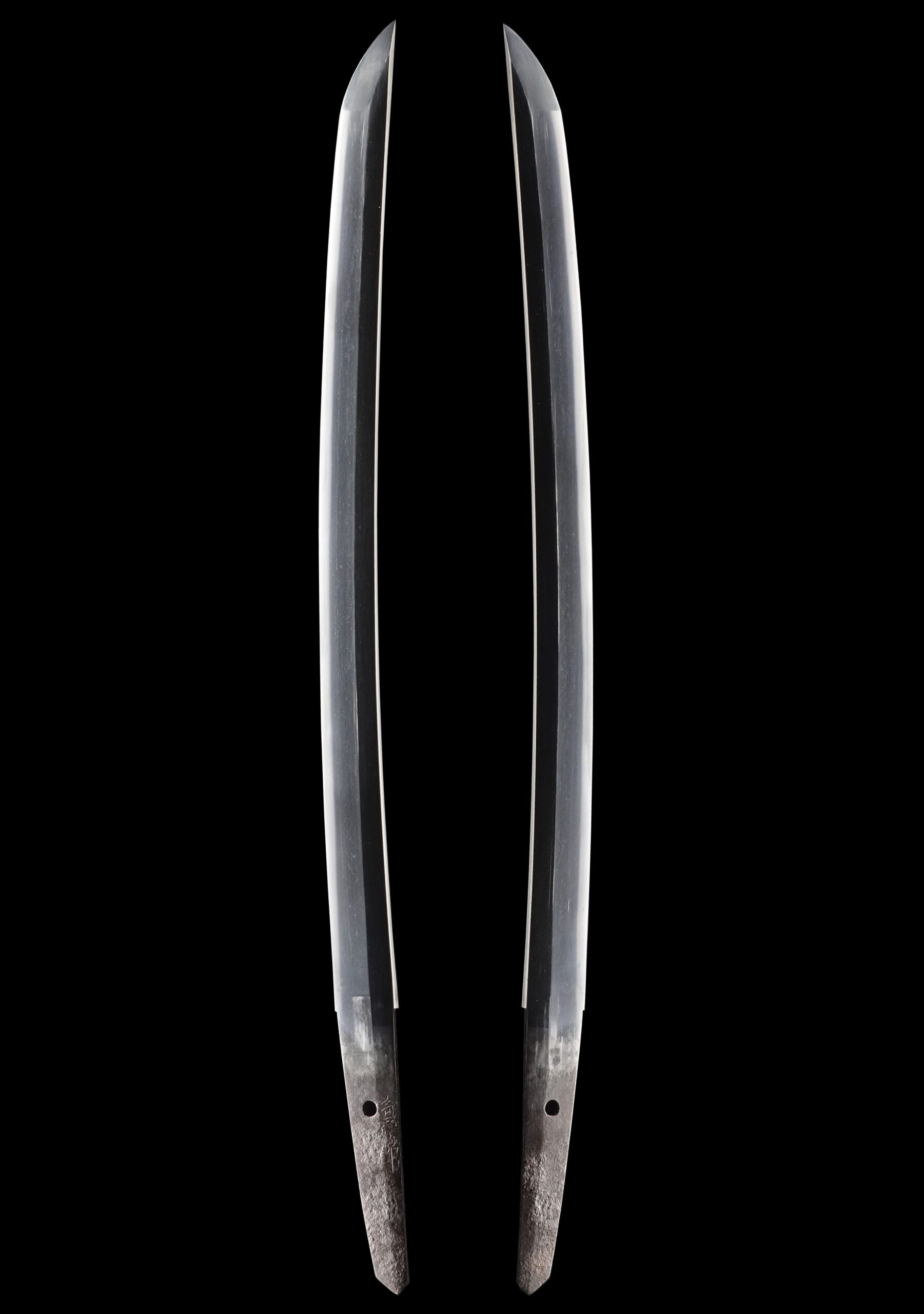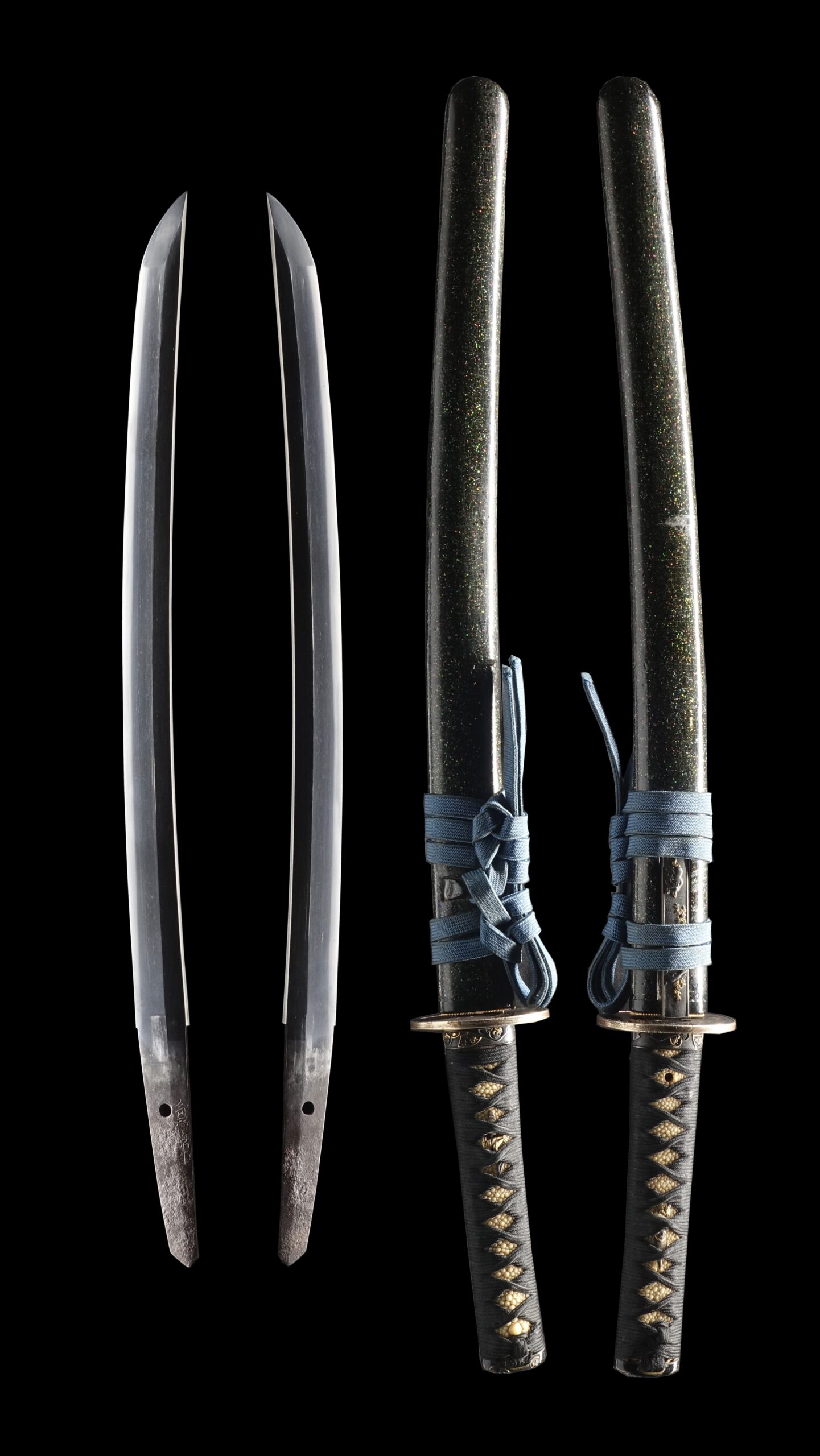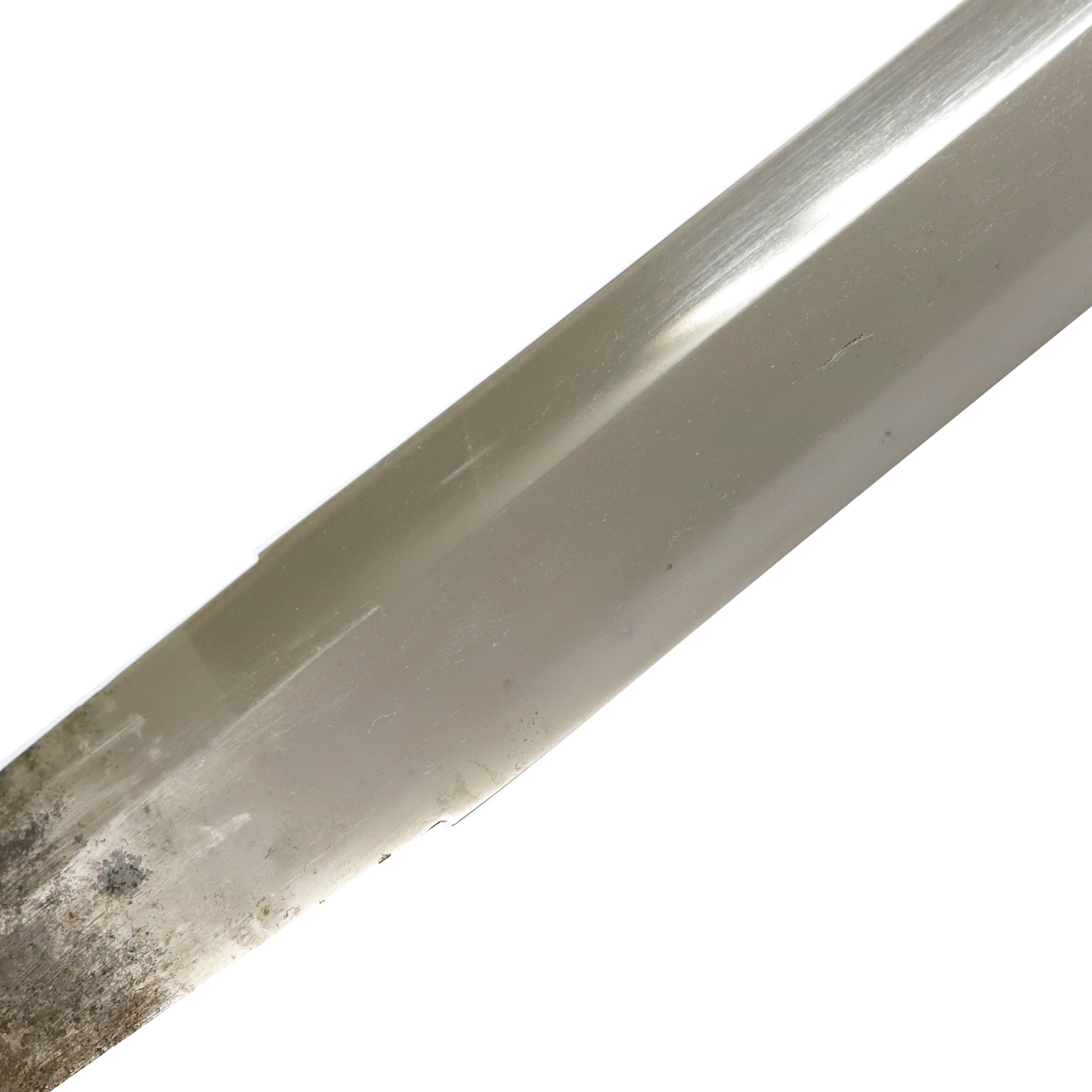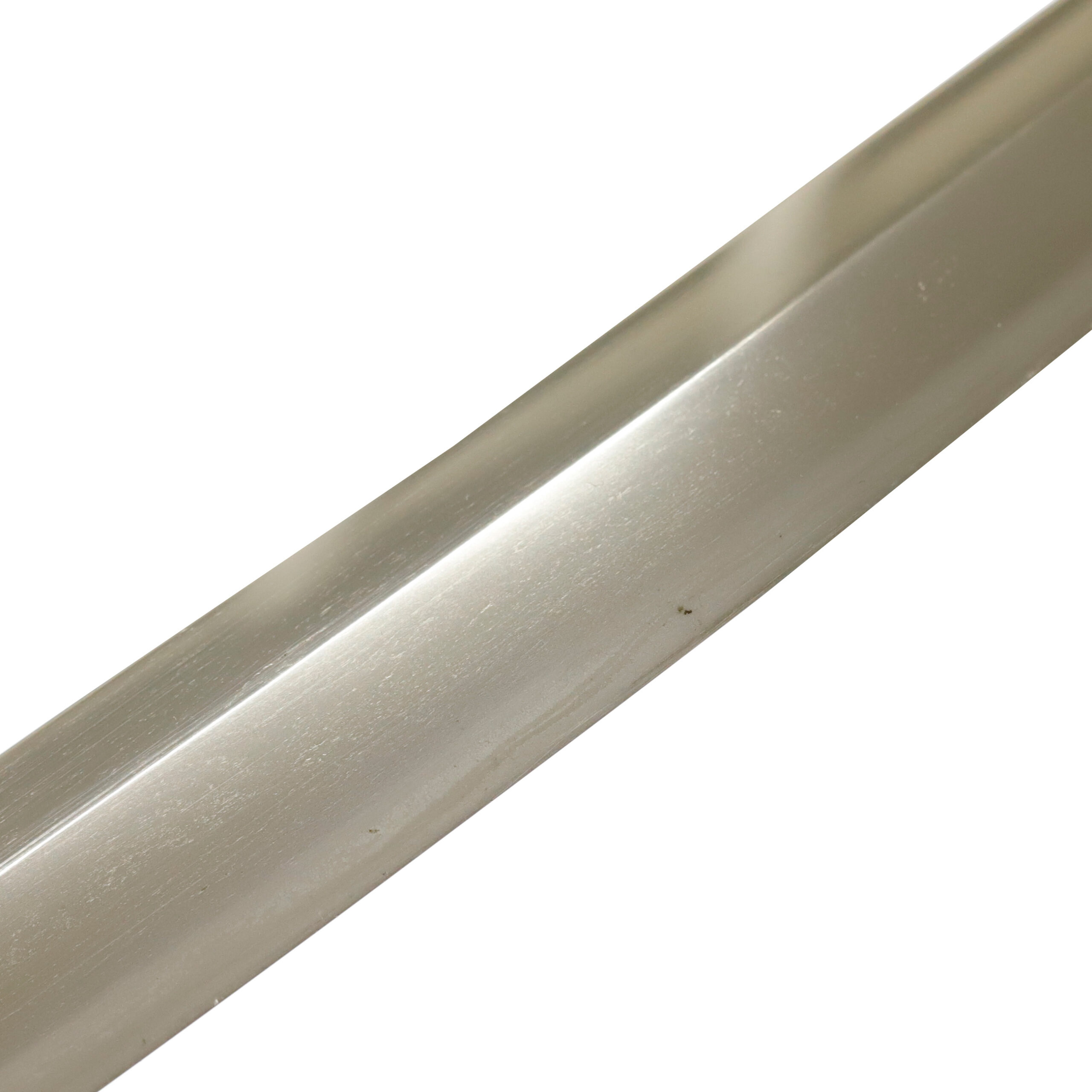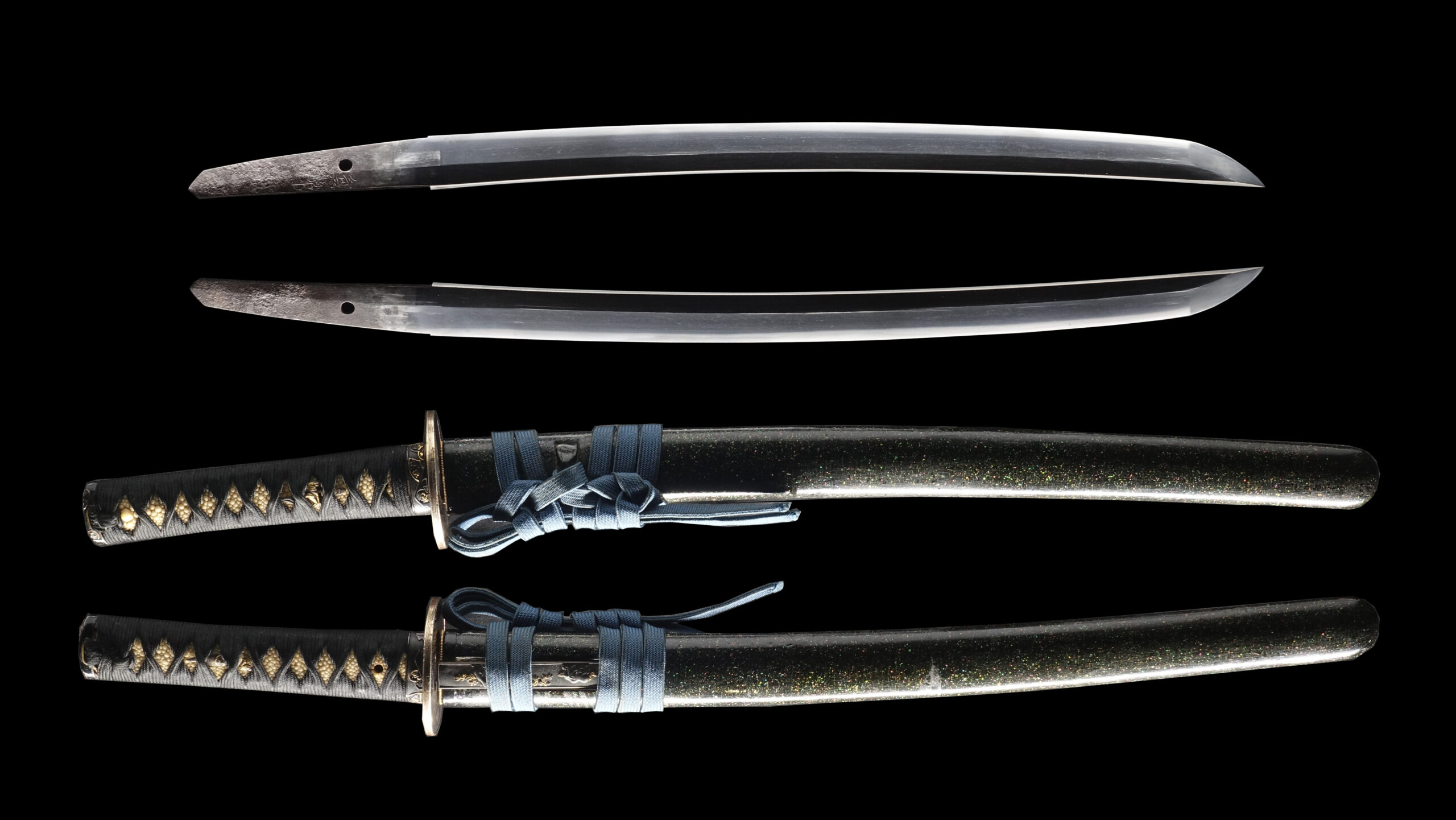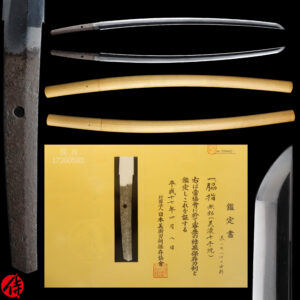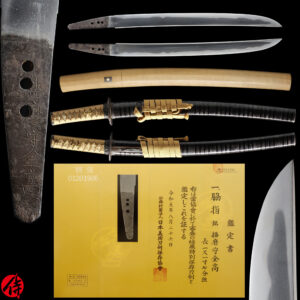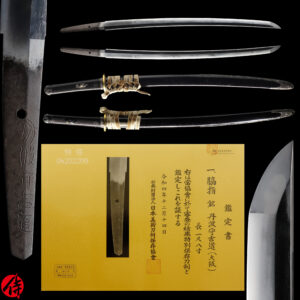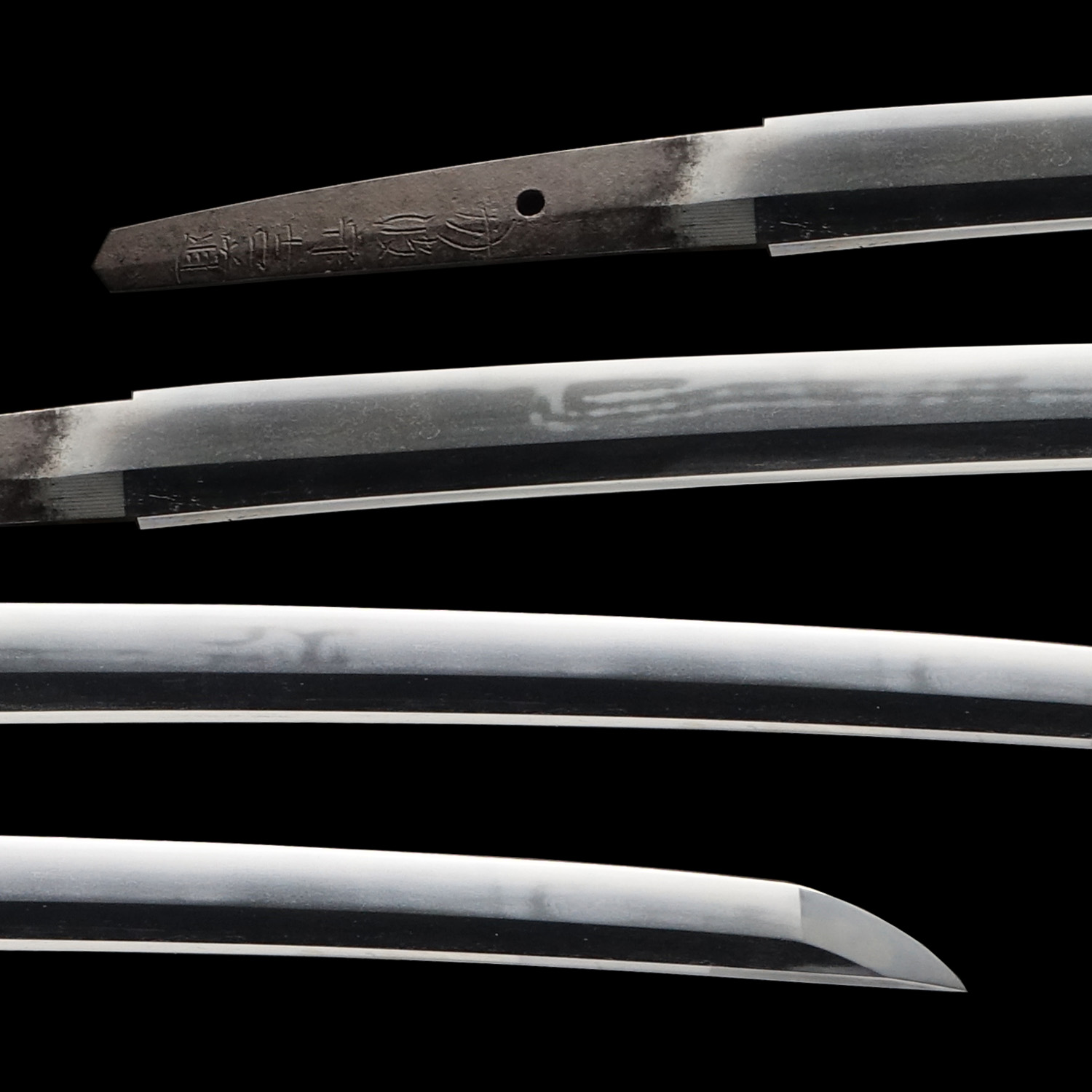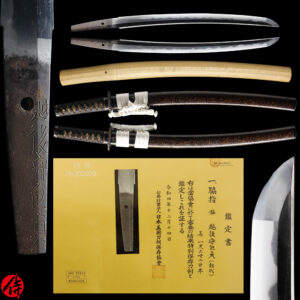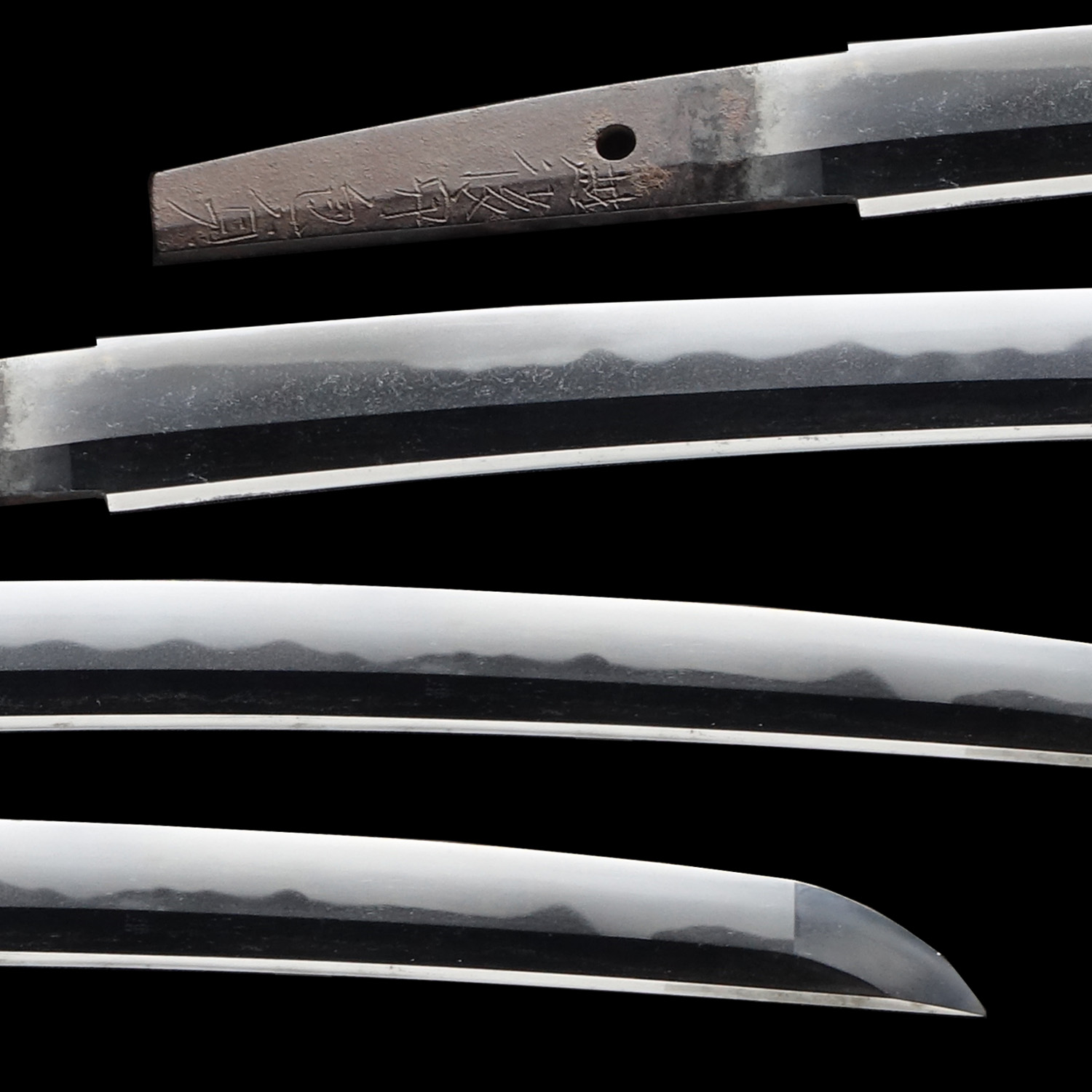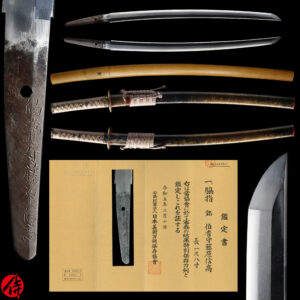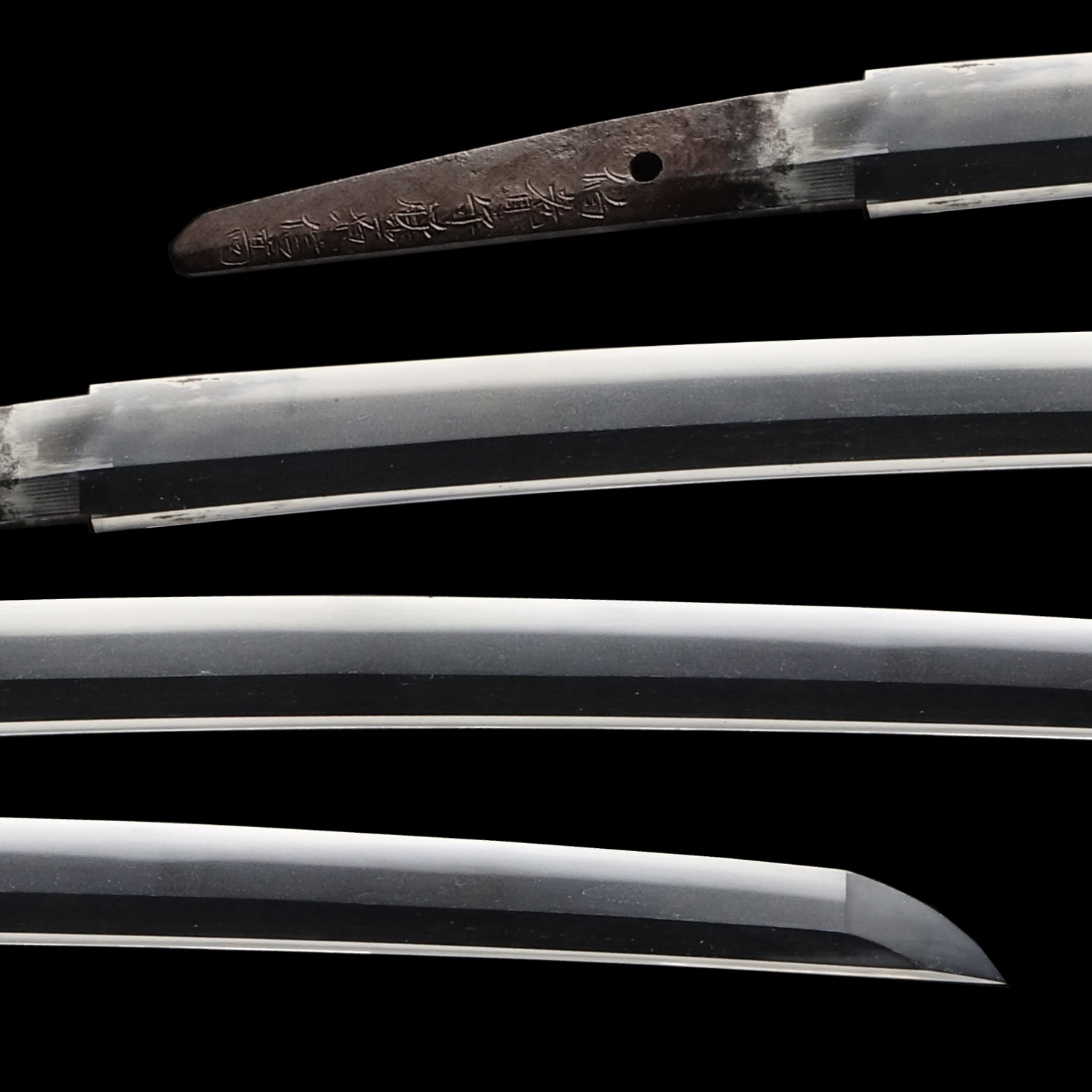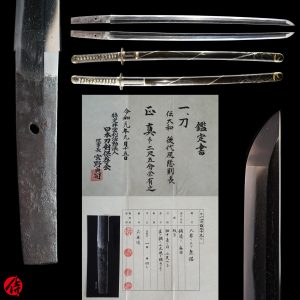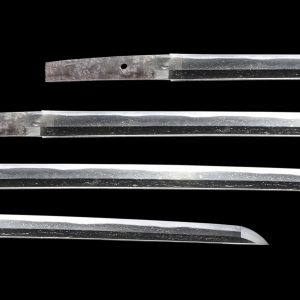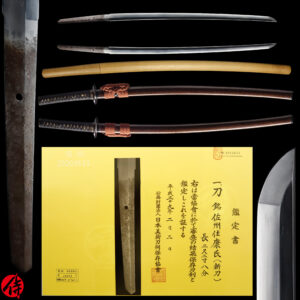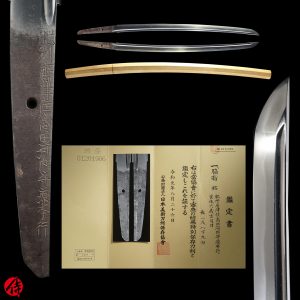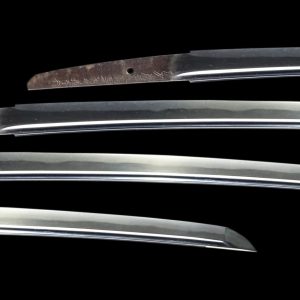Antique Japanese Sword Wakizashi Signed by Kanetsune with NBTHK Tokubestsu Hozon Certificate
【Description】
This blade was signed by Kanetsune (兼常), also known as Sagami no Kami Masatsune (相模守政常). Kanetsune was the previous maker’s name used by Masatsune. He was active during 1573-1592 (Azuchi Momoyama period). In this description, we will address him as Kanetsune and Masatsune.
Kanetsune was born as the second son of Suke Uemon Kanetsune in the third year of the Tenbun era (1534: Late Muromachi period). His father was also a renowned swordsmith in Mino province (Today’s Gifu prefecture).
It is said that he learned sword-forging techniques from his father. And, in 1567, when he was 33 years old, he became an independent swordsmith and signed as Kanetsune (兼常), moving to Komaki village in Owari domain (Today’s Aichi prefecture).
According to available records, he and his school forged 100 spear swords, which Tokugawa Ieyasu ordered for Komaki Nagakute Battle in 1584. Masatsune received an honorable official title of Sagami no Kami in 1592 and changed his maker’s name to Masatsune after Ikeda Terumasa (池田輝政), the head of the Kamaki domain, gave one of his letters to Kanetsune. It was common to let a swordsmith use one of the Kanjis in one lord’s first name as a token of great craftsmanship, such as Masatsune (政常).
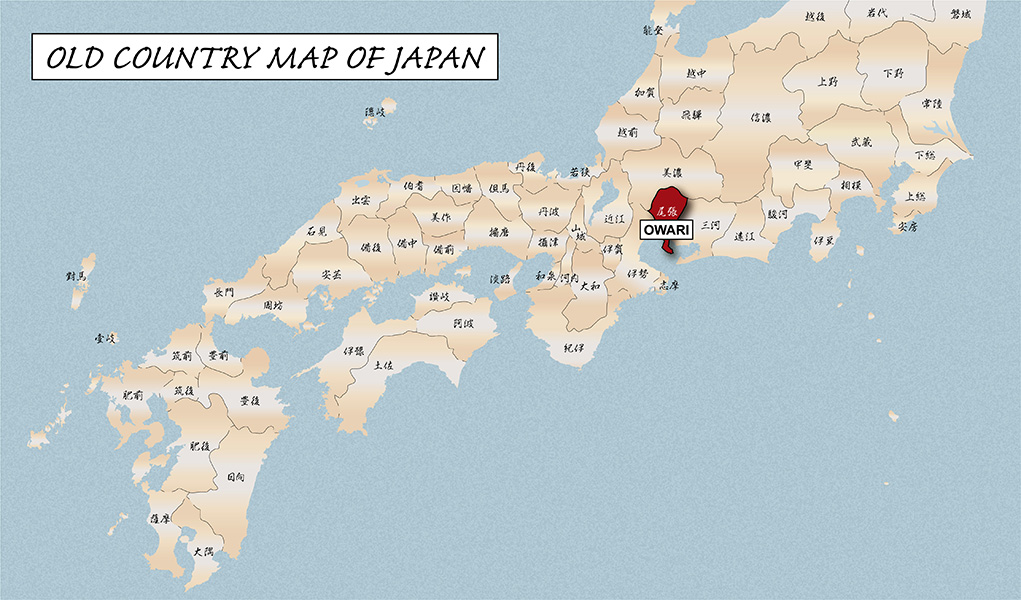
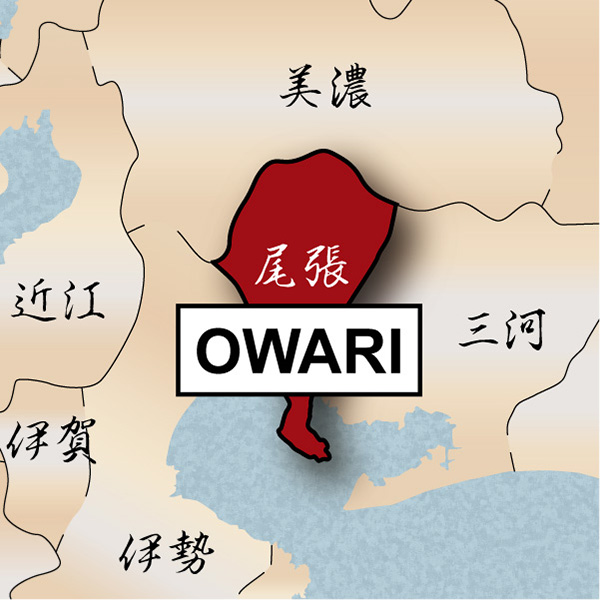
When Masatsune was 66 years old in 1600, Satsuma no Kami Matsudaira Tadayoshi, the 4th son of Tokugawa Ieyasu, became the head of the Kiyosu castle, the headquarter of Owari domain. And, Fukushima Masanori, one of the most famous Samurai who served Hideyoshi Toyotomi, ordered Masatsune to relocate from Komaki village to the castle town near the Kiyosu castle. And, Masatsune started to serve Tadayoshi as an Okakaekaji, exclusively forging blades for his master. In the same year, the head of the Owari domain changed to Tokugawa Yoshinao, 9th son of Tokugawa Ieyasu. And Masatsune and his son started serving Yoshinao. Masatsune once retired in the 12th year of the Keicho era (1607), but he returned to forge blades because his son died unexpectedly. He eventually adopted his heir from Omichi school in Mino province. Masatsune lived until he was 85 years old.
As Owari province(today’s Aichi prefecture) was active in martial arts during the early Edo period, there was much demand among high-class Samurai to order swords forged by Masatsune. Masatsune is also known as an Owari Sanketsu, one of the three famous swordsmiths in Owari province. The other two are Hidano Kami Ujifusa and Hoki no Kami Nobutaka.
This blade is appraised as a Tokubetsu Hozon Token(特別保存刀剣) issued by NBTHK(Nihon Bijutsu Touken Hozon Kyokai:日本美術刀剣保存協会). This authentication paper was only given to authentic Japanese swords, especially well preserved and high quality with artistic value.
*Please keep in mind that there is a couple of Kitae Kzu on the blade. If you like to see the detailed condition, please feel free to contact us.
【Blade】
Cutting Edge Length(Nagasa):44.4 cm (17.5 inches)
Curvature(Sori):1.0 cm (0.39 inches)

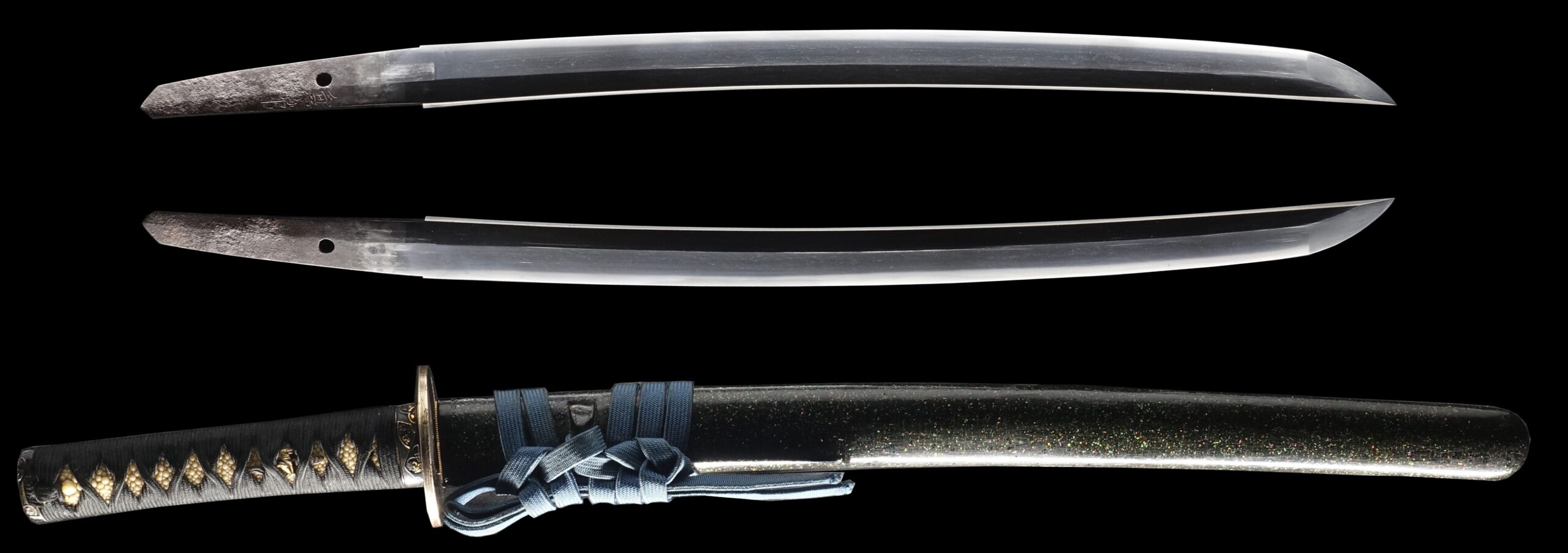
Hamon:
The crystalline structure which forms along the cutting edge of a blade as a result of the hardening process
Jimon(Jihada):
visible steel surface pattern created by folding and hammering during forging process
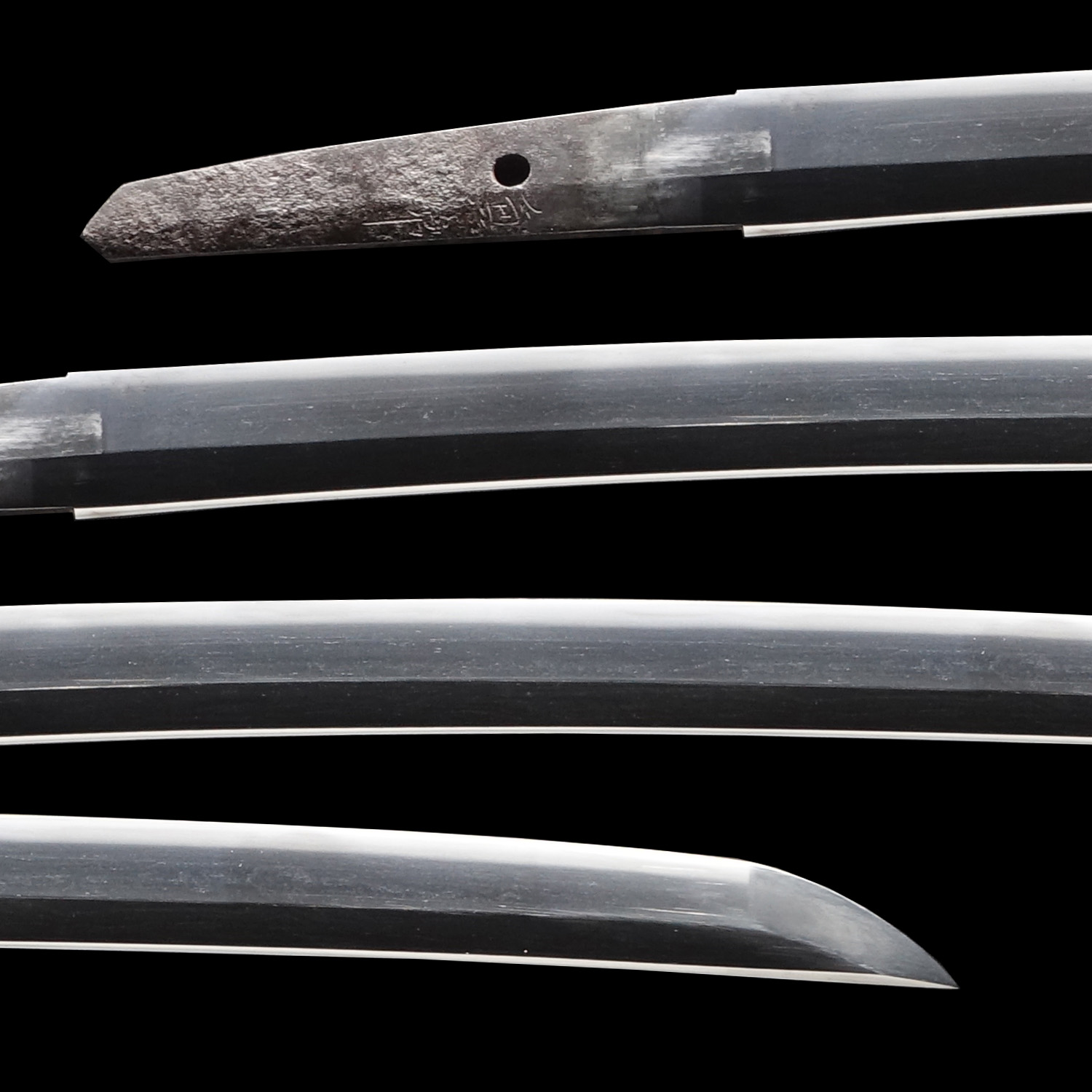
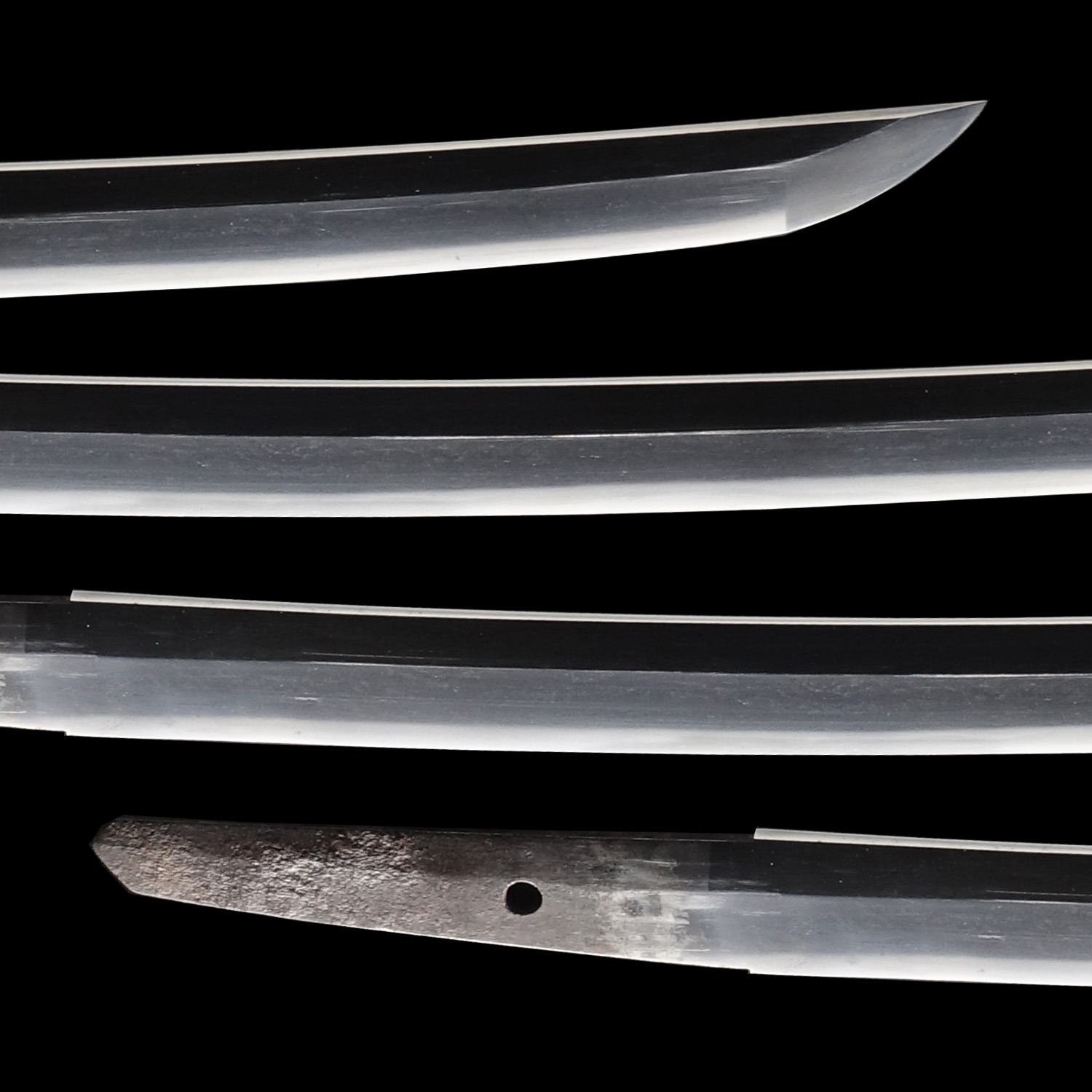
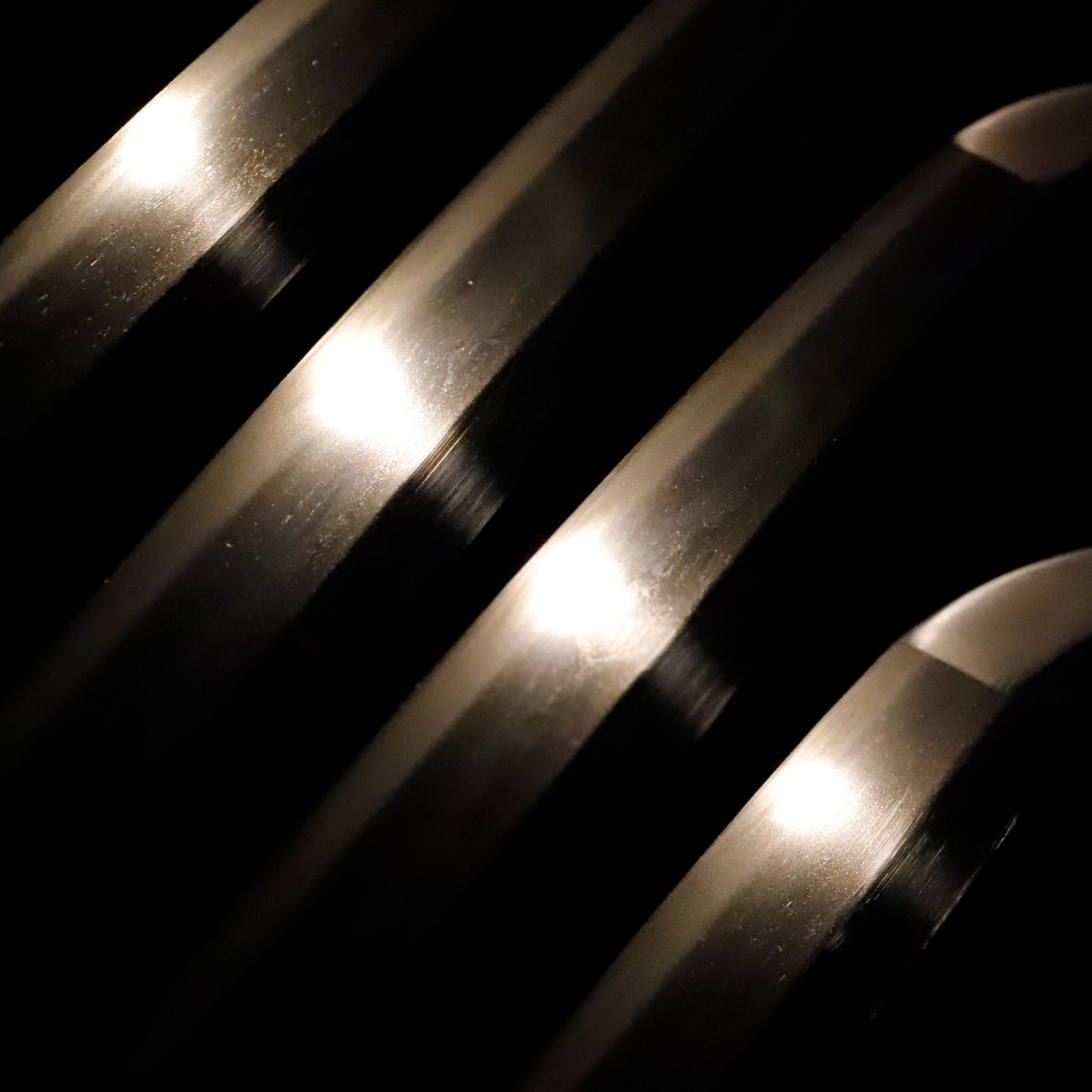
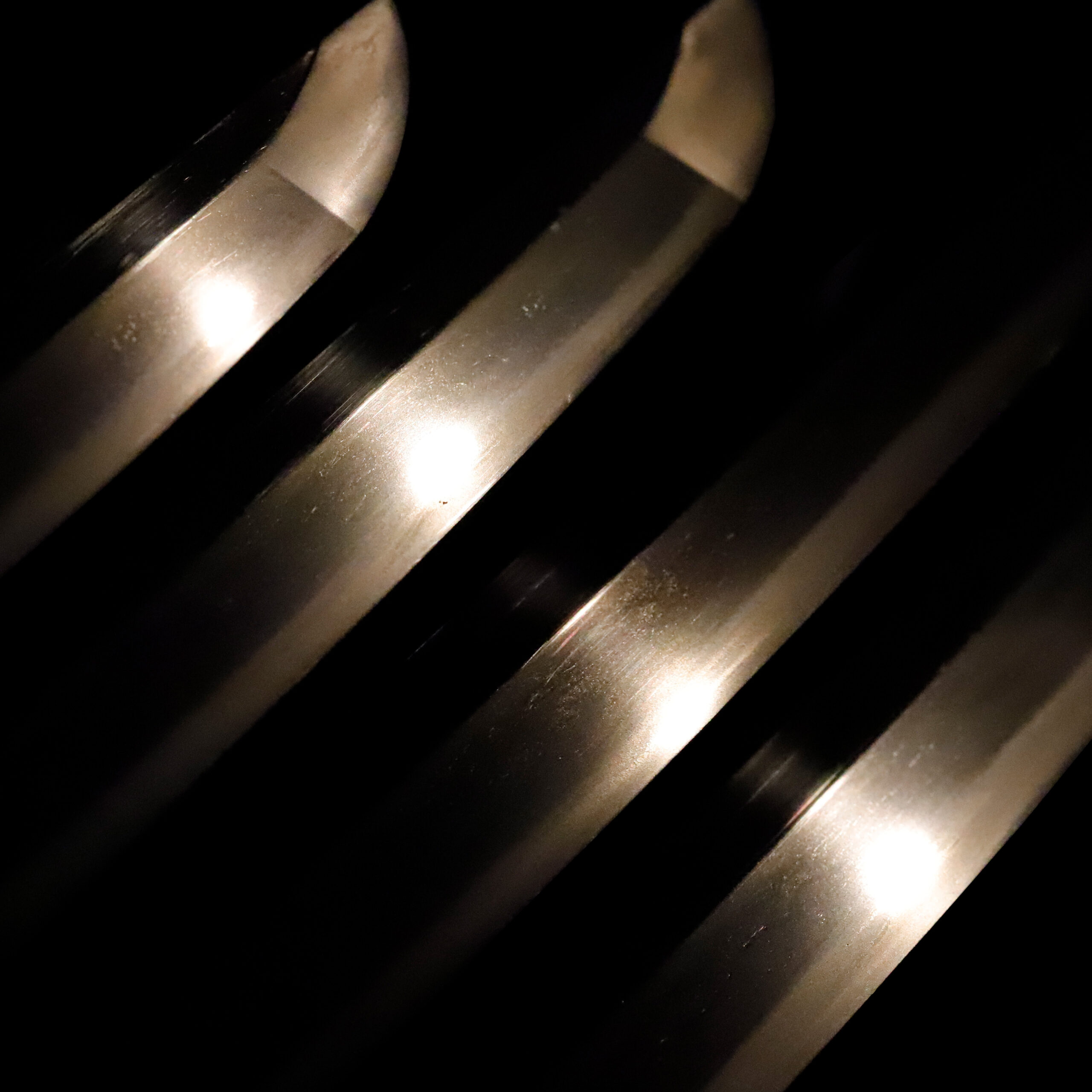
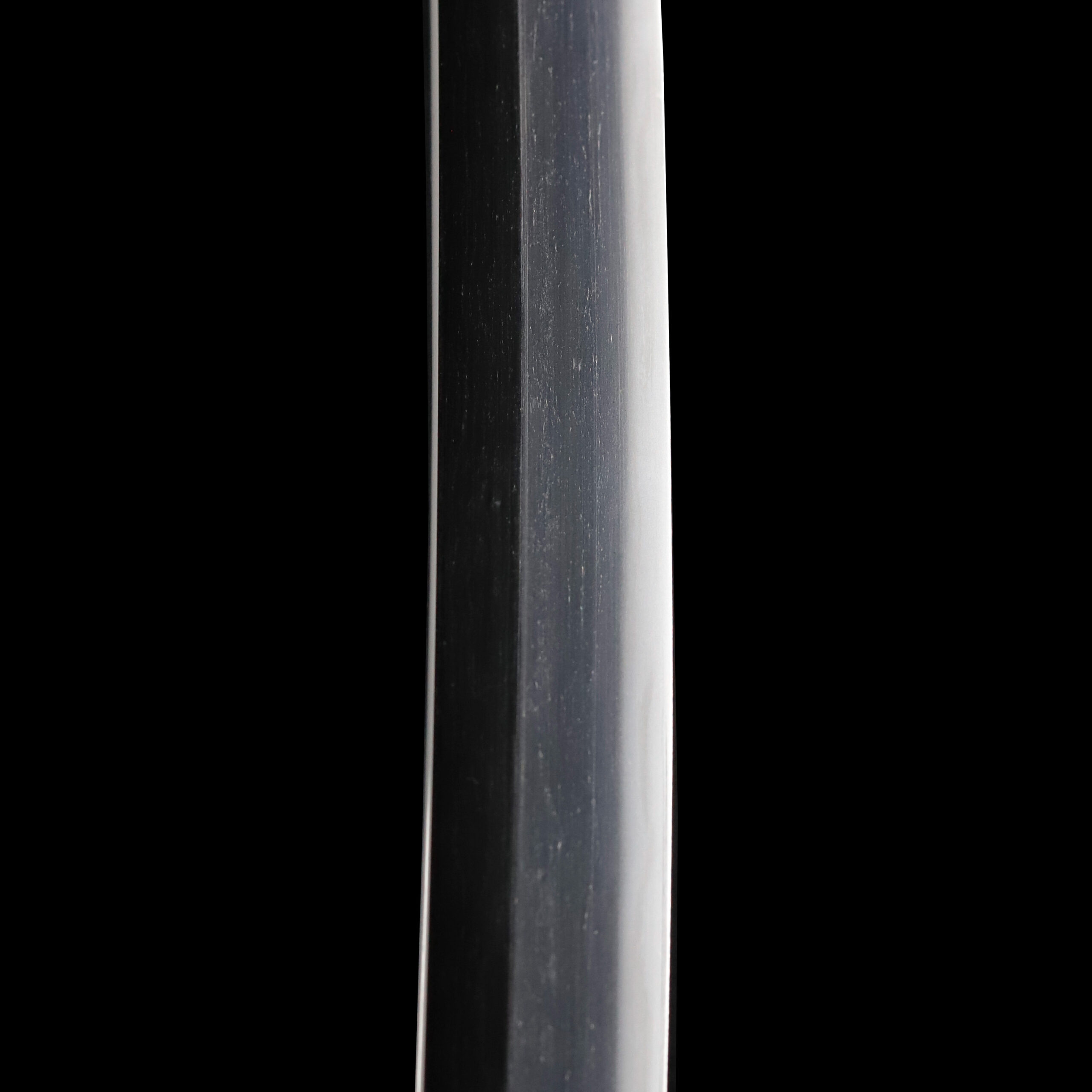
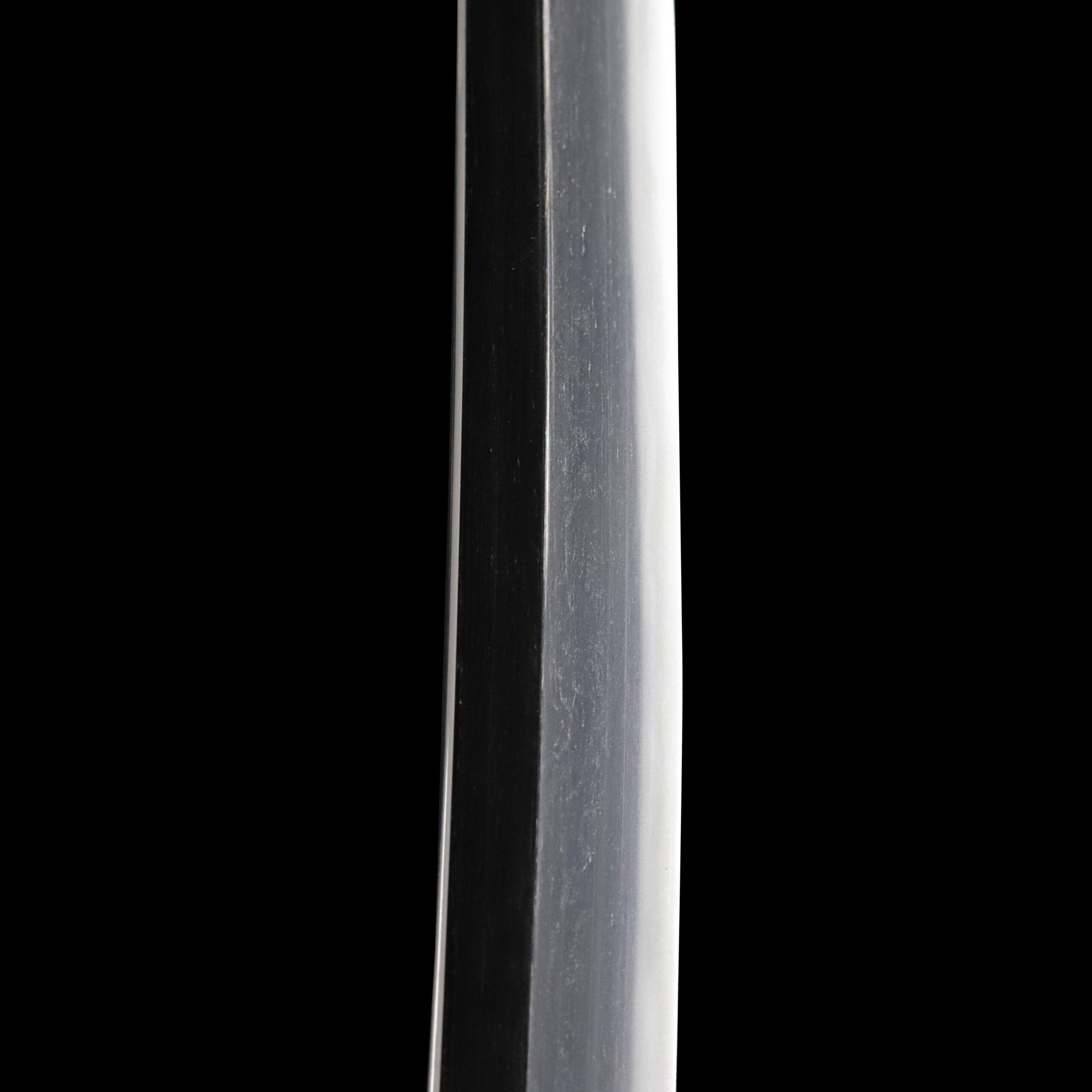
Nakago:Nakago is the tang of the Japanese sword.
Japanese swordsmiths left the black rust on the tang because it prevents red rust while the tang is in its handle. And the discoloration of the tang was created over time, and it is a great indicator for a Japanese sword specialist to estimate when the sword was forged.
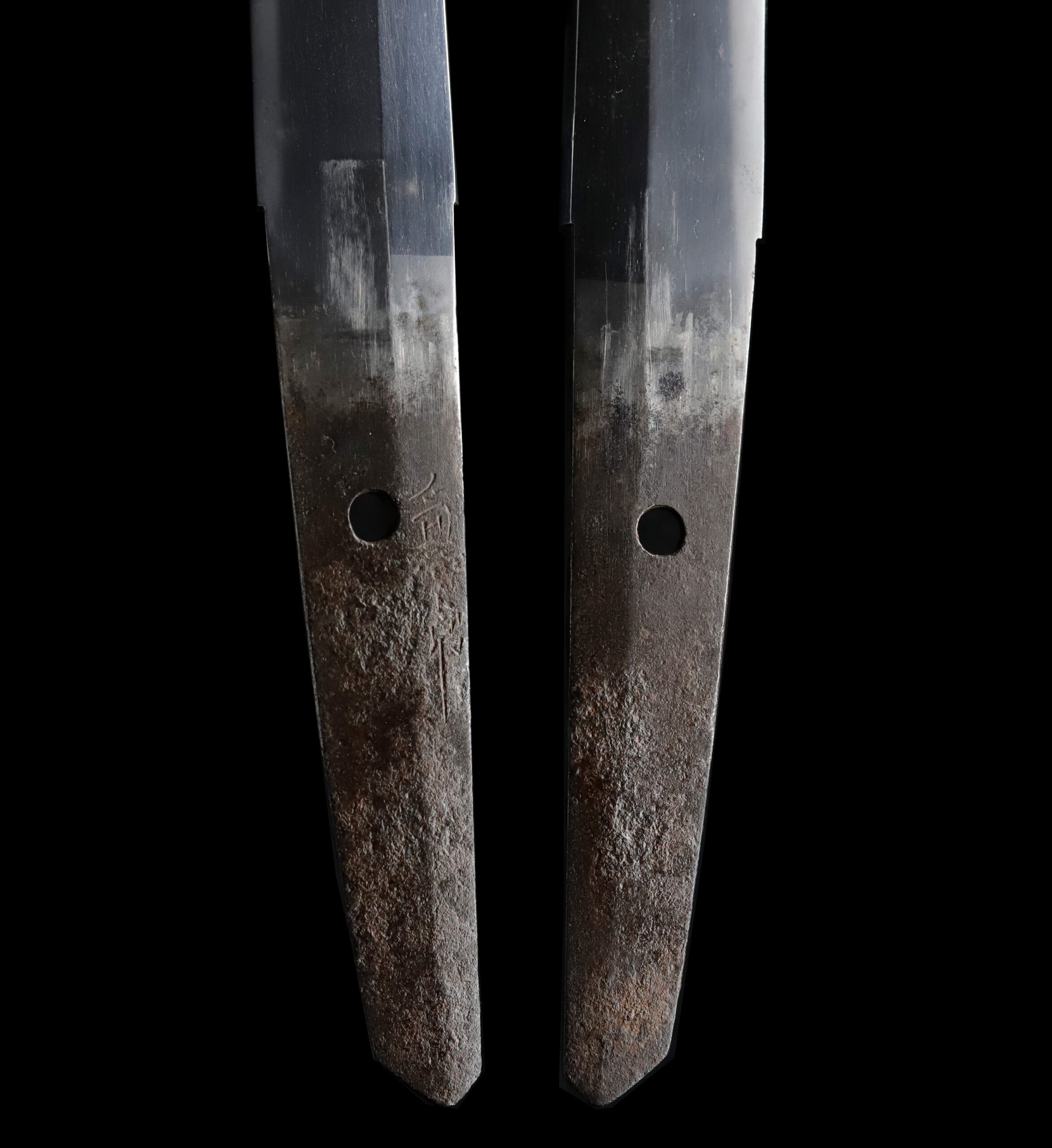
Koshirae: Koshirae is the mounting of the Japanese sword. There are several parts that consist of Koshirae such as Saya(Scabbard), Tsuka( Handle), Tsuba(Handguard).
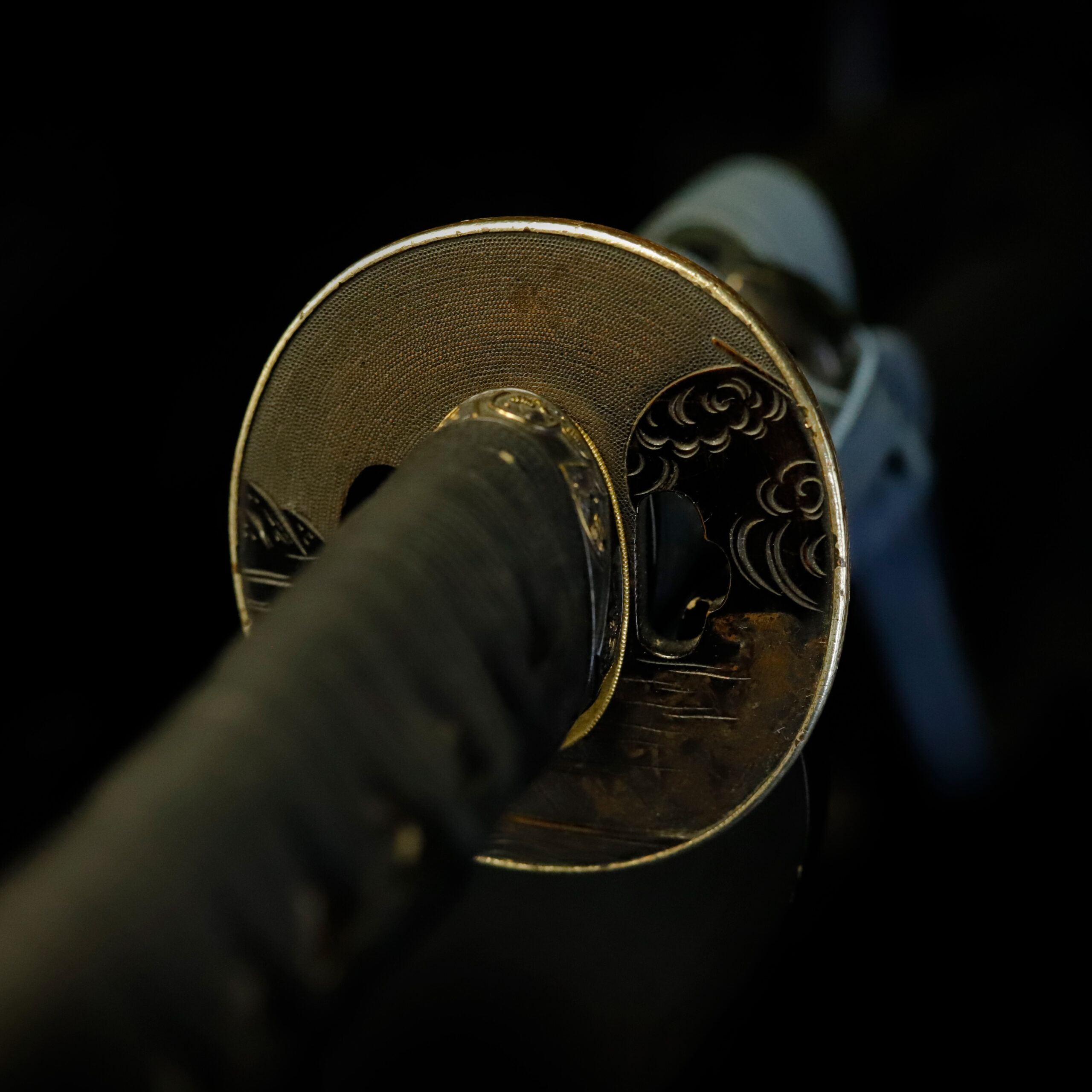
Fuchi-Kashira:A pair of matching sword fittings that cover the upper and bottom parts of its sword hilt.
The surface of this Fuchi Kashira is decorated with the Nanako-Ji (魚子地) technique. This process makes a uniform minimal protrusions pattern by hitting the Nanako-Ji Tagane (魚子地鏨, a chisel for this technique) on a metal surface. This decorative technique is often seen on sword mountings. Although several colorings have already faded due to aging, we could see that golden paint is applied to some parts, making this metal fitting look ornamental. Each fan-shaped or heart-shaped frame has a plant design engraved inside it; these motifs are the elements of this Fuchi Kashira’s decorativeness.
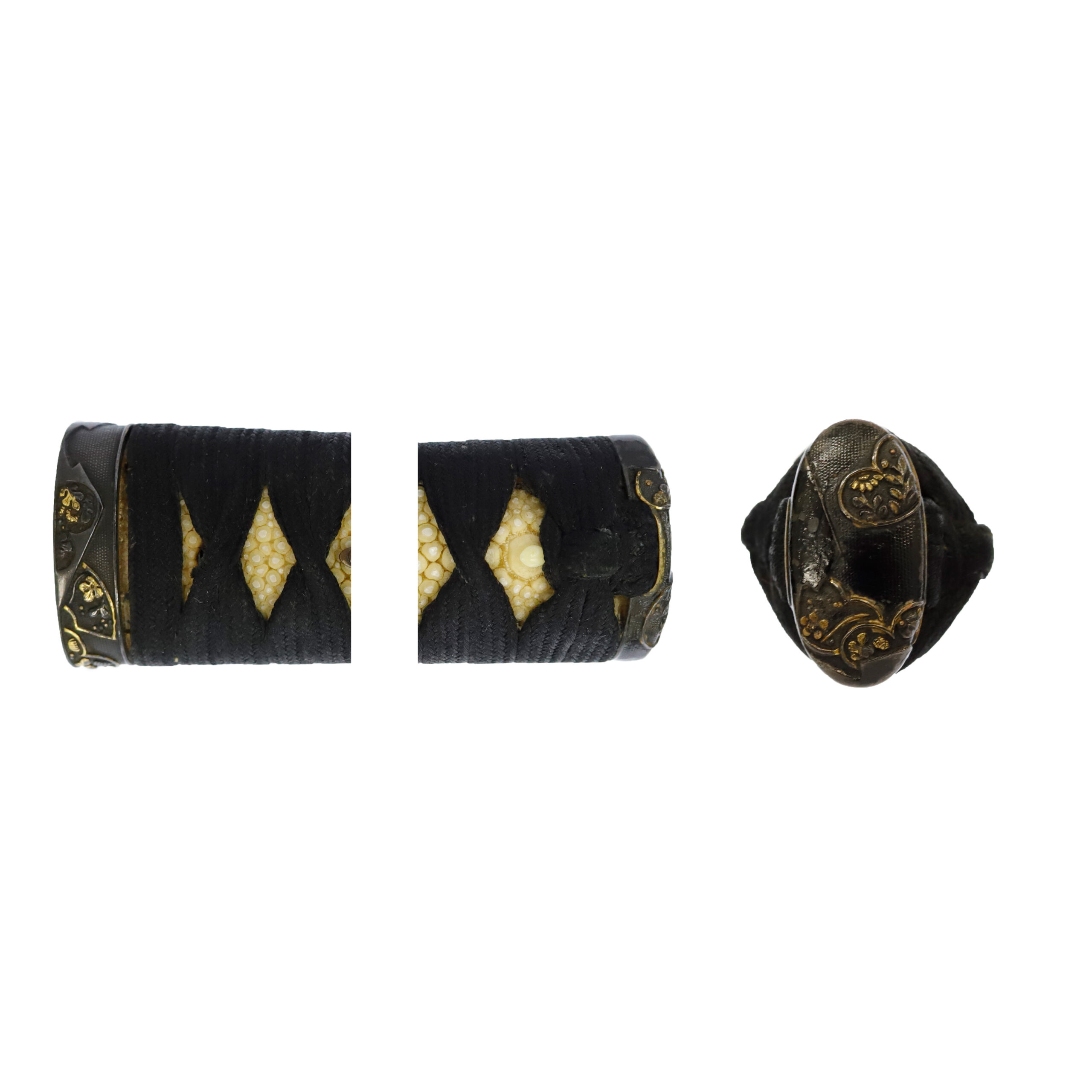
Tsuka and Menuki:Tsuka is the handle of the Japanese sword and Menuki is its decoration.
Seeing from the gaps of the Tsukamaki thread, the theme of this Menuki is the Tsuru Kame Mon (鶴亀文, crane and turtle pattern) in Japan. It is a classical Japanese pattern. According to a theory, the idea of the Tsuru Kame Mon is an auspicious design that has existed since the Heian period. And people have used it as a design since the Edo period. A proverb says these animals have long lives, such as, it is said that cranes live one thousand years, and turtles live even ten thousand years. Therefore, this motif is considered a symbol of longevity.
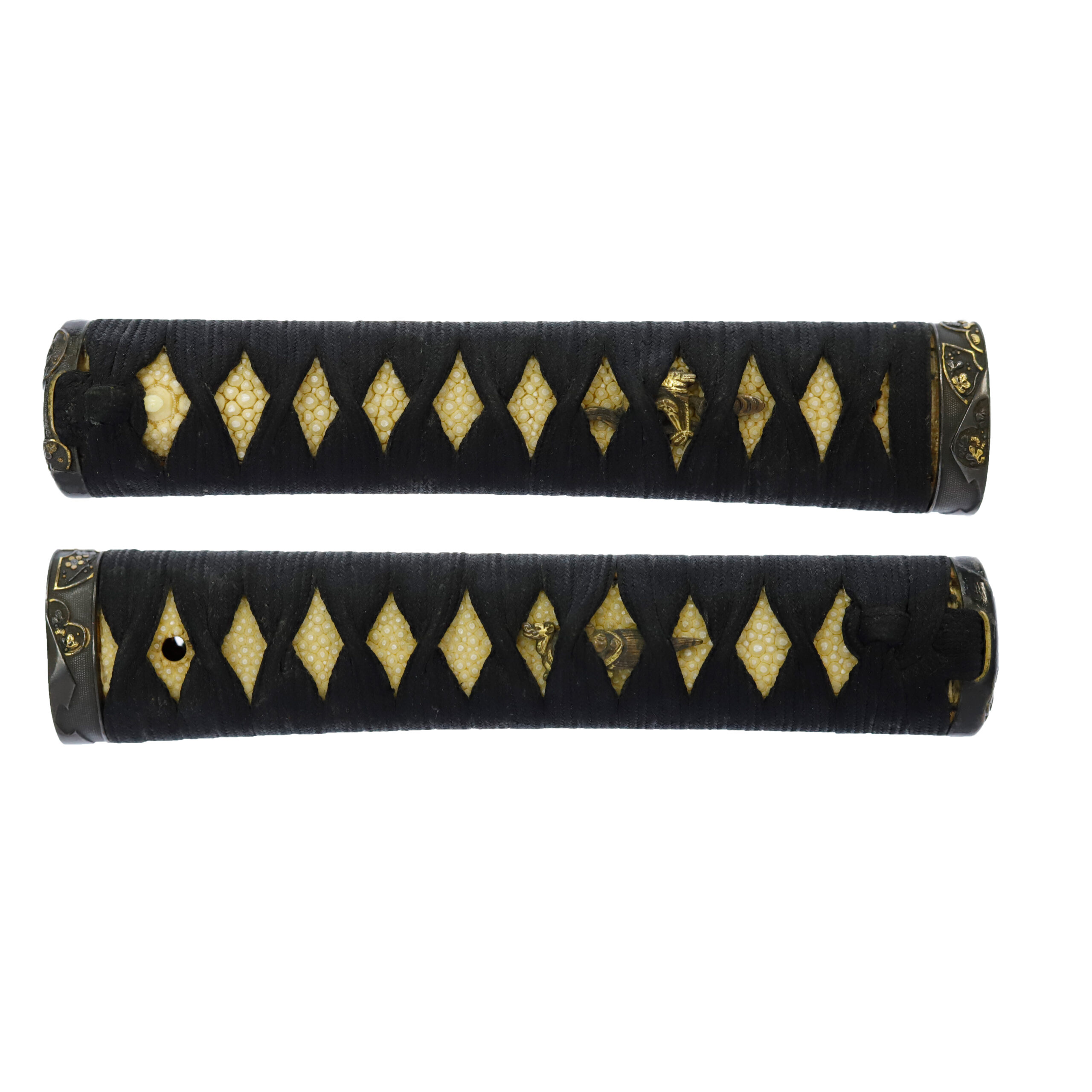
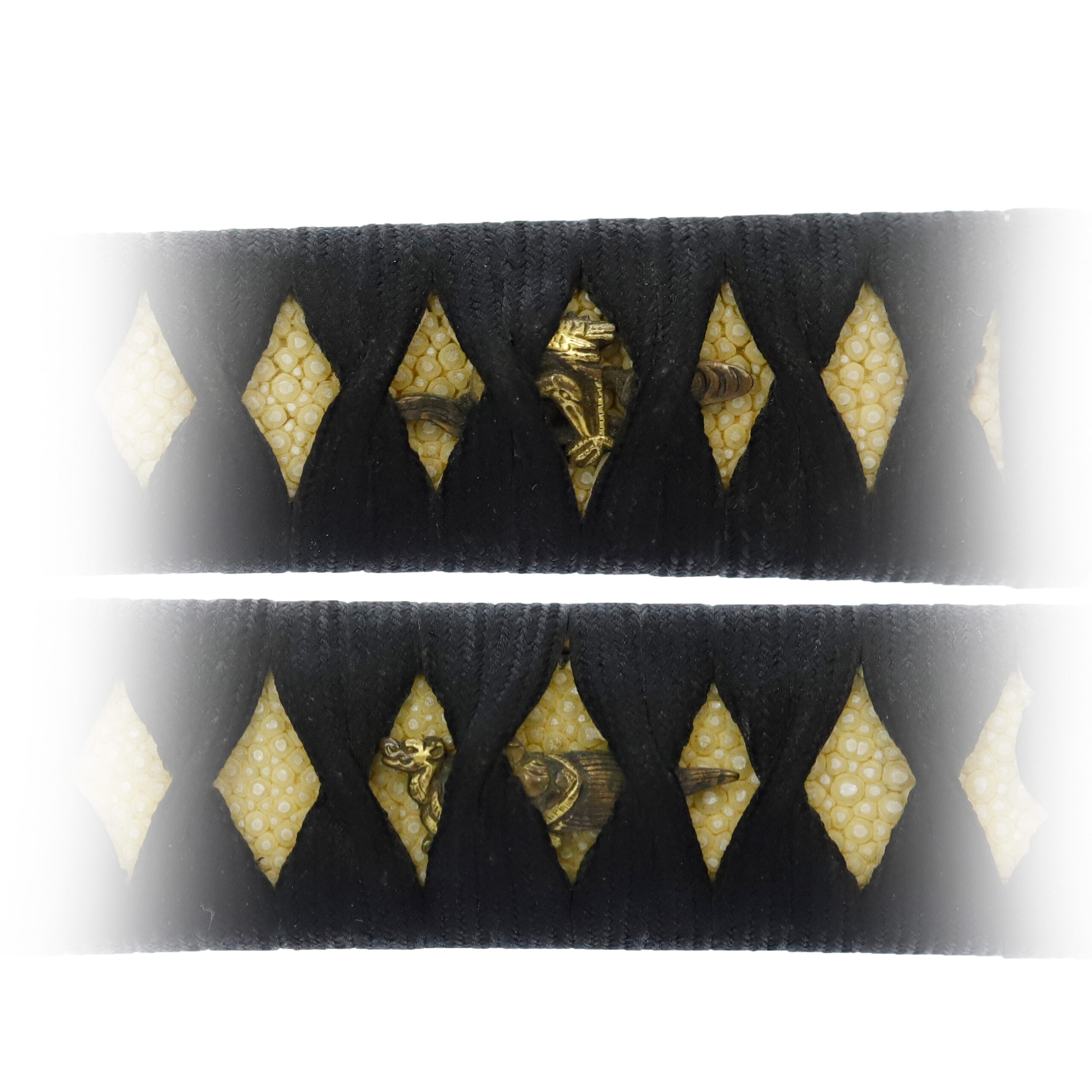
Tsuba and Habaki:Tsuba is the handguard for the Japanese Sword and Habaki is the equipment to make the blade not touch its scabbard inside. It prevents the blade from getting rusty and chipped.
Oval-shaped Tsuba that has Kozuka and Kougai holes. Its Mimi (耳, edge) part is framed with a thin metal plate. This process not only enhances the beauty of the work but also its practicality. This frame increases the Tsuba’s strength, eliminating the risk of damaging the fabric due to friction with clothing. The design depicts a seaside scene, with the obverse showing a calm water surface and a floating ship.
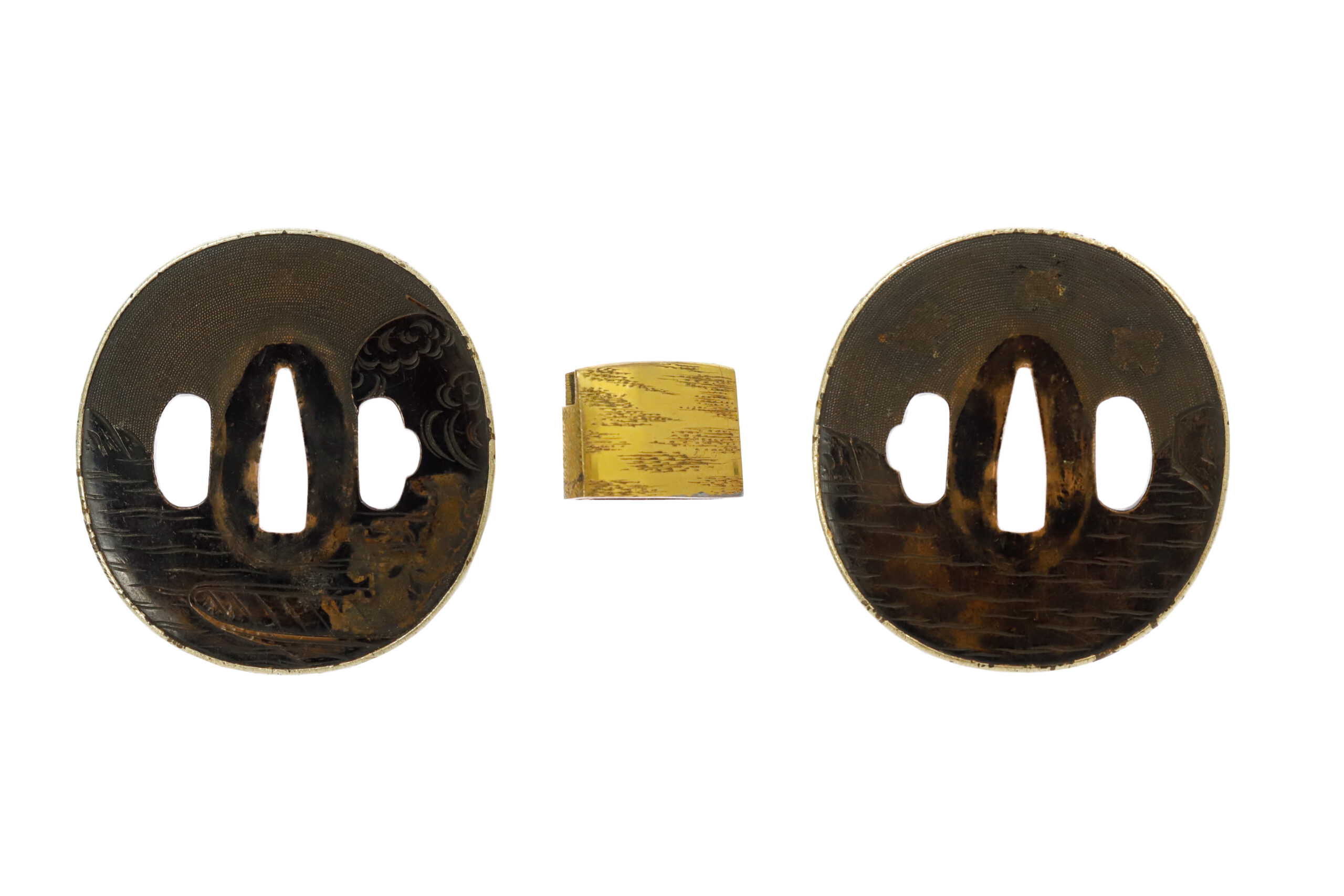
Saya: Saya is the scabbard for the Japanese sword.
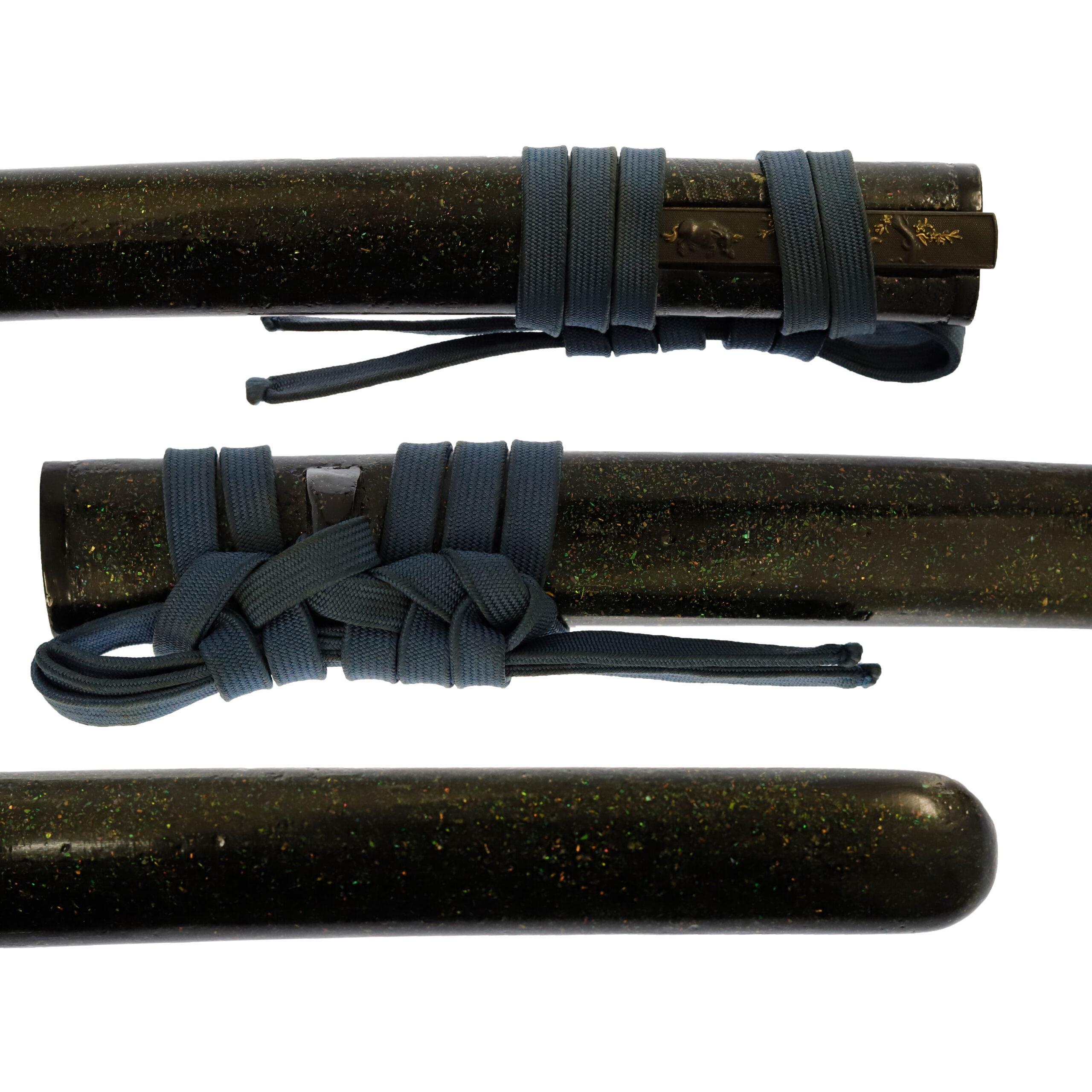
Kozuka:Kozuka is a small knife stored in Kozuka Hitsu(groove of the sheath of the Japanese sword).
A Kogatana (小刀, small knife) is stored in the Kozuka. If you focus on the blade part, you would find an engraved inscription. It is written as follows: 関 兼定 (Seki Kanesada). We think it shows its maker’s name. However, please note that there is no proof of this signature.
About the design of this Kozuka, its surface is decorated with the Nanako-Ji technique, the same as the Fuchi Kashira and Tsuba. You would see the figures of two cows. Cows have been familiar with human life since ancient times. They are indispensable in multiple situations: food, labor force for farming, or carrying goods. People have thought this hard-working animal’s figure symbolizes integrity. According to a theory, that is why the cow was added to the Junishi (十二支, the twelve signs of the Japanese zodiac). In addition, the Japanese name of cow, “牛,” is also written as “丑.” There is the letter “紐,” which means string in Japanese. Now you would notice that “丑” is used in the “紐” character. Therefore, there is an idea that considers “丑” has meaning, such as connect (tie) or take (grasp). Based on these ideas, Samurais might have associated this animal design with meanings such as “form a connection” or “grab the victory” and incorporated this design for sword mountings, as you see in this Kozuka.
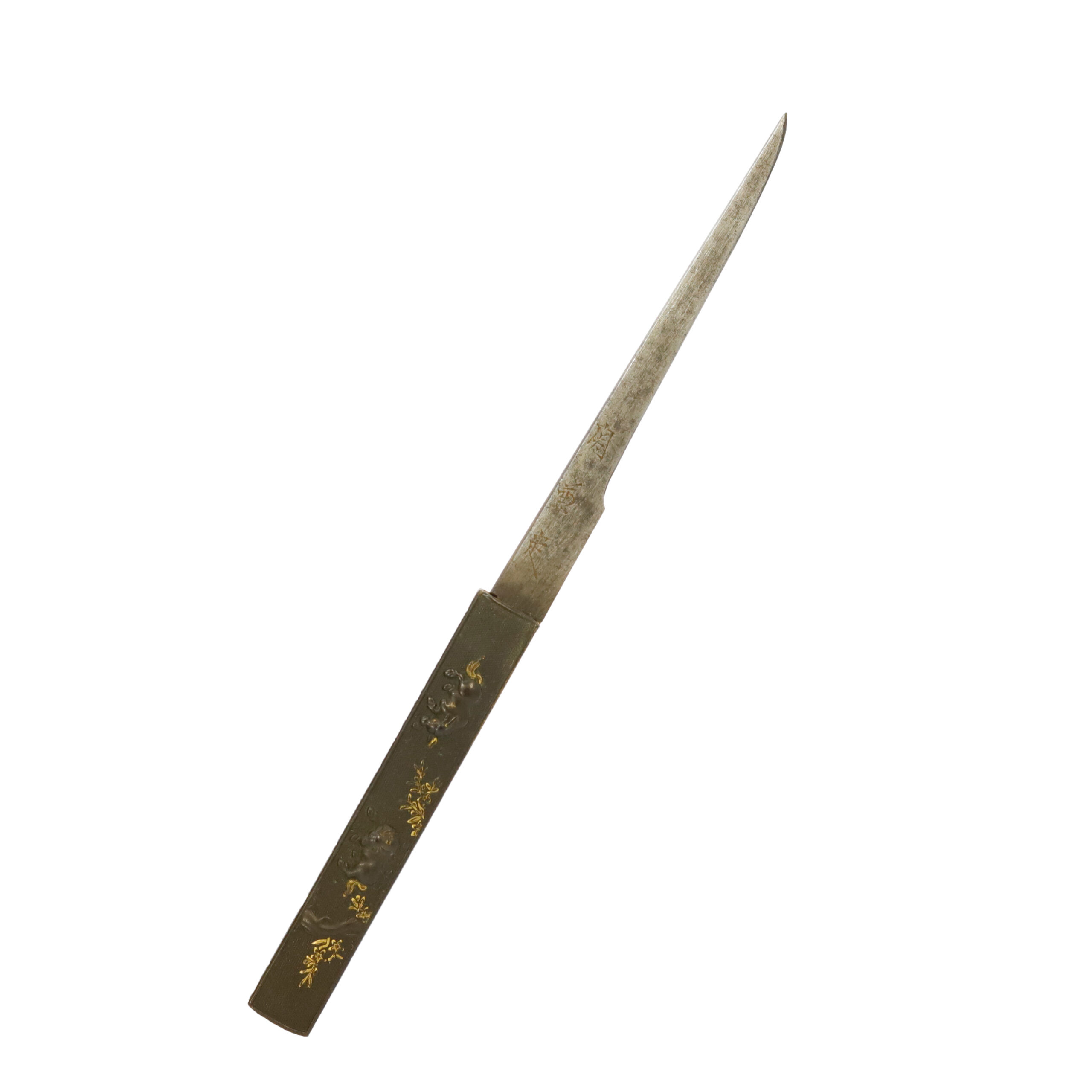
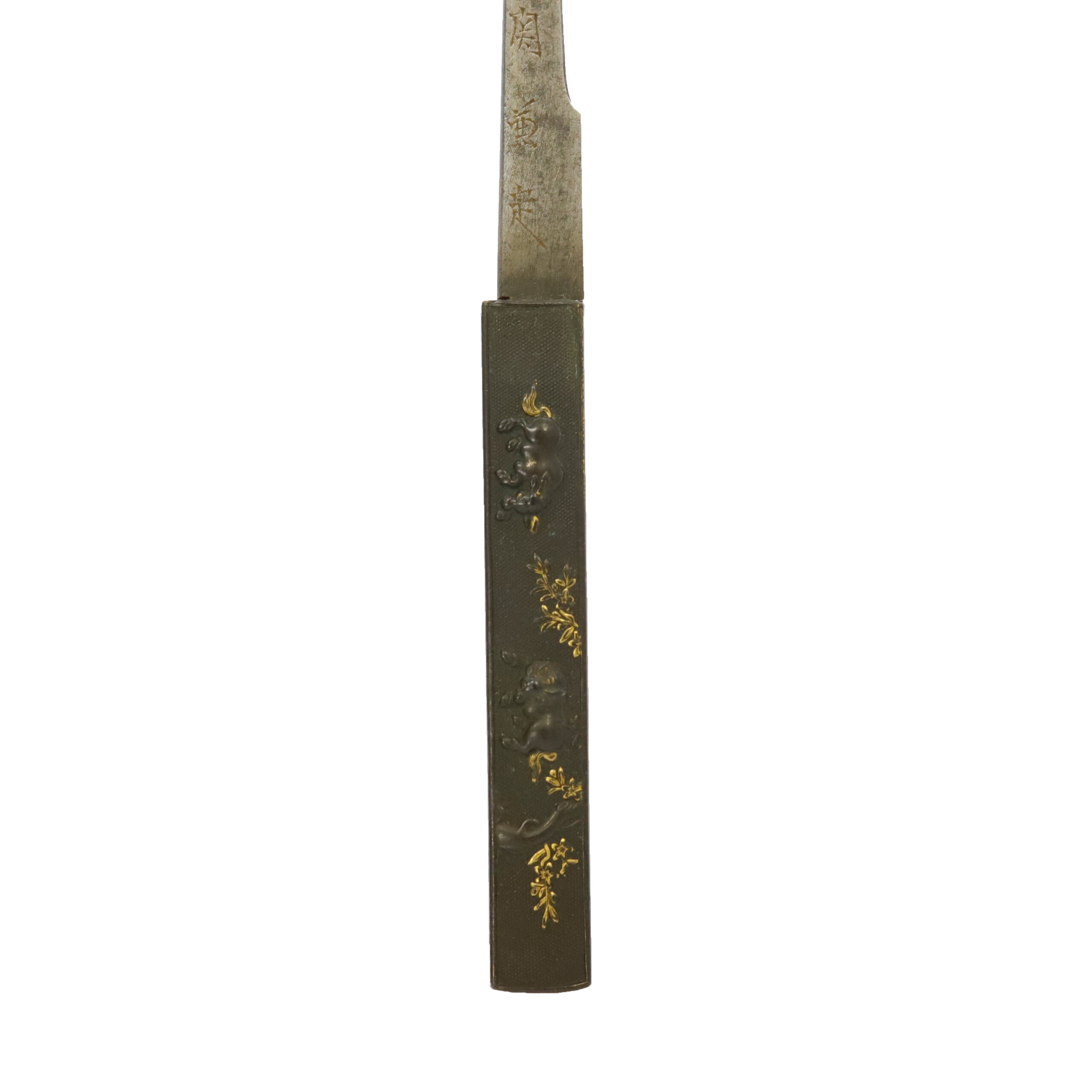
Authentication Paper:NBTHK Tokubetsu Hozon Certificate for the blade (No. 1018175)
NBTHK, also known as Nihon Bijutsu Touken Hozon Kyokai (the Society for the Preservation of the Japan Art Sword), is one of the oldest Japanese sword appraising organizations in modern-day Japan. They authenticated the blade on June 3rd in the 4th year of Reiwa (2022). They appraised it as Tokubetsu Hozon Touken, the blade especially worth preserving for Japanese society. The purchaser will receive this original certificate as well. We can also translate what is written into English and make a PDF file for your record if you request.
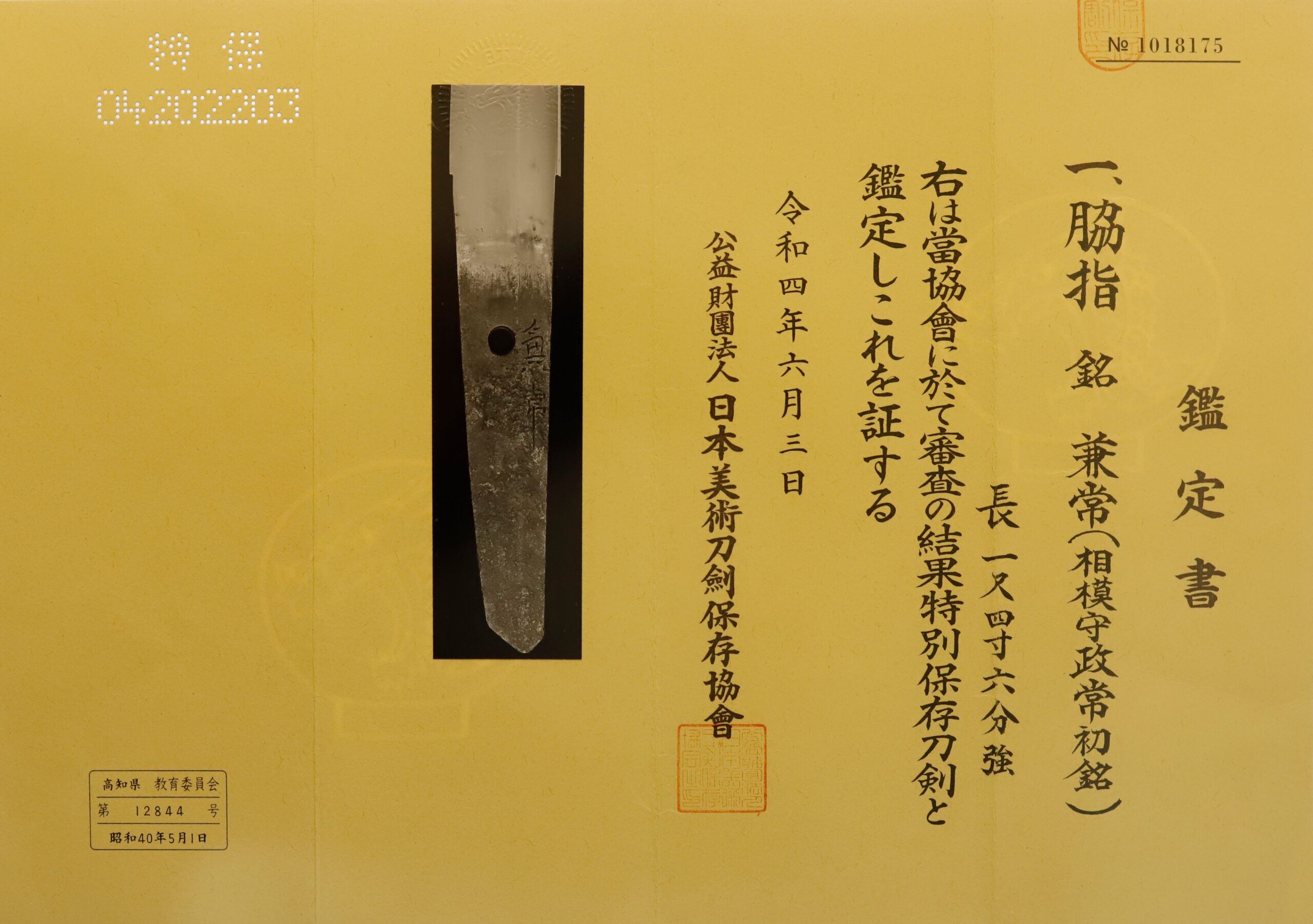
Registration Number : Kouchi 12844
The Board of Education in Kouchi prefecture issued a registration paper for this sword. It is called Jyu Token Rui Torokusho(銃刀剣類登録証). Bunkacho(The Agency for Cultural Affairs) acknowledges a Japanese sword with this paper as a work of art.
The sword needs to be traditionally hand-forged and made of Tamahagane carbon steel to be registered in the system. With this paper, its owner in Japan can legally own an authentic Japanese sword. Based on this registration number, we will apply for its export permit.
This paper will need to be returned to the board of education when the sword is being shipped abroad, but you can receive a copy of it. An English translation of this registration paper is available on request.
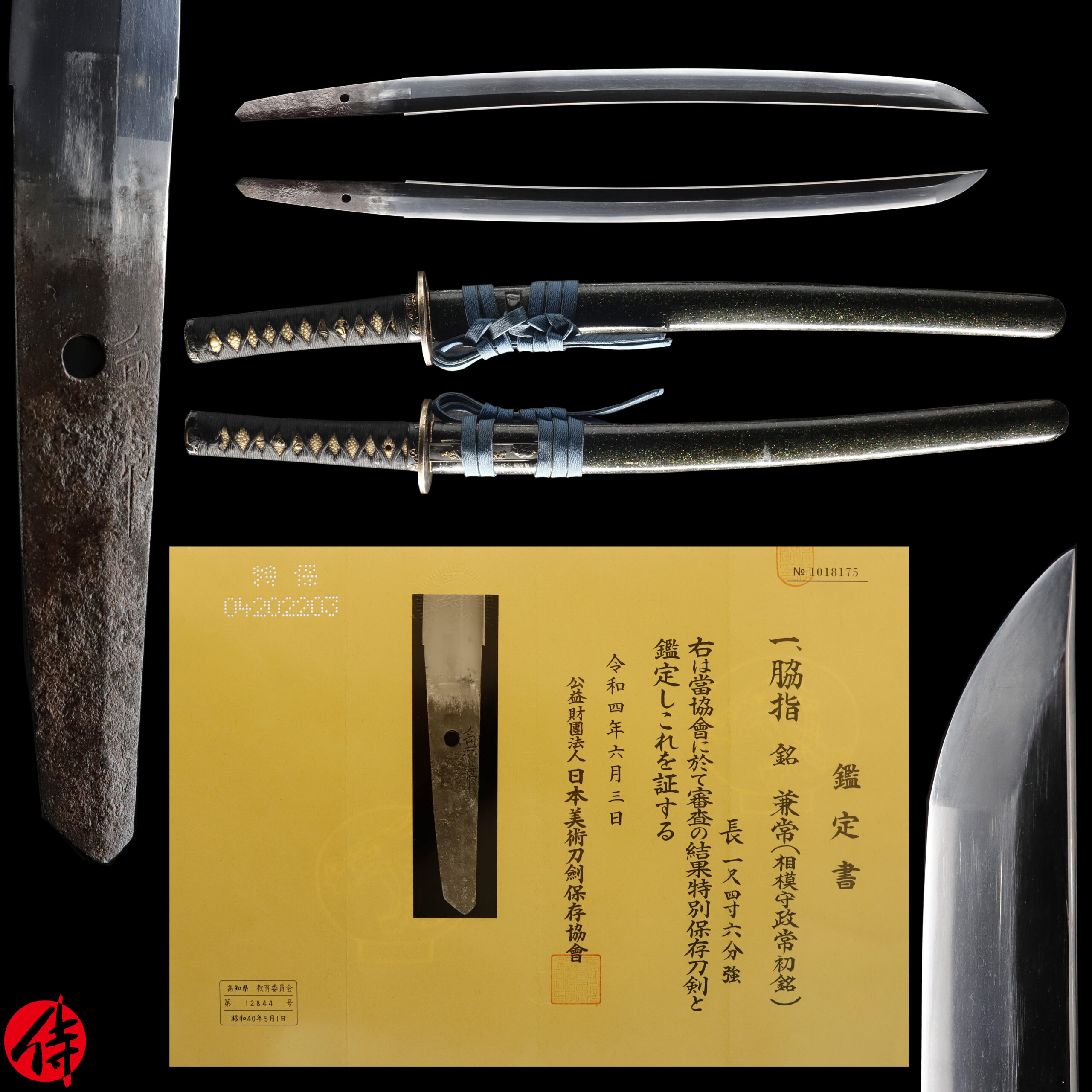
—————————————————————–
【About us】
Samurai Museum is located in Tokyo, Japan, exhibiting antique artifacts related to the Samurai history. Samurai Museum Shop is the place for those who are interested in Japanese culture and craftsmanship. We deal with antique Samurai swords/armor, traditional crafts made in Japan and so on.
【Review】
Here is one of the reviews we received from a customer who purchased an authentic Japanese sword from us. For more reviews, please click here.
“My experience overall with the whole process was wonderful. I had many questions about the history and process to purchase these treasures. All my questions were answered very timely and complete. The staff is very knowledgeable and very well versed if any questions do arise.”
【Japanese Sword& Export Process】
The Japanese swords we deal with are hand-forged edged swords made in Japan. It was made from the traditional carbon steel called TAMAHAGANE(玉鋼). Samurai Museum is familiar with the proper legal procedure for an antique/ authentic Japanese sword to be exported from Japan. We have sent more than 500 Japanese swords for the past three years (~2023) to amazing owners who appreciate its historical value.
Each Japanese sword is registered under the Agency for Cultural Affairs and the Board of Education in Japan. They issue a registration paper for each Japanese sword for its owner in Japan to legally possess it. The Japanese sword with its registration paper means it was traditionally hand-forged in Japan.
To legally export the sword from Japan to other countries, we will have to apply for its permit to the Agency for Cultural Affairs(Bunkacho) and return the original registration paper to the Board of Education. It normally takes around 2-4 weeks to receive this permit after submitting required documents. And we would like you to expect at least 1-1.5 months for your order to arrive at your given address after you ordered. For more detailed info, please click here.
It is allowed for residents in Japan to own authentic Japanese swords without a special license as long as they come with registration papers. Please feel free to contact us if you are a resident of Japan, whether temporarily or permanently. We will also assist you when you leave Japan and need to obtain the export permit.
【Payment Method】
We accept payment through Stripe (Credit card), PayPal, Apple Pay or ChromePay, all of which are secure payment methods. Also, you don’t need to make an account on Stripe for the checkout. If you prefer other payment method, please contact us. After confirming your payment, we will apply for an export permit. You may either pay in JPY, USD, AUD, CAD,EUR CHF or GBP. The price is set in Japanese Yen. Prices in other currencies are automatically calculated based on the latest exchange rate.

* If the amount is above 1 million JPY, Stripe or wire transfer will be the only options for payment.
【Shipping】
We have shipped authentic Japanese swords to the USA, UK, Canada, Mexico, Germany, France, Hong Kong and Australia. If you don’t live in these countries and like to order, please contact us first before making a purchase. We offer Free International Shipping as long as we can send antique Japanese swords by EMS.
We normally ship by EMS(Express Mail Service) provided by Japan Post. We will send you a tracking number for your order as soon as we hand it to the post office. We will put 100 % insurance on the shipping document without any extra charge. Based on the total amount, there might be a duty tax or other fee for you to pay, depending on the countries. We use package cushioning to protect the item and put it in a PVC pipe, which is one of the most secure packages because of its durability.
It will normally takes 5-14 days for the item to arrive at your given address after we dispatch it. Time of delivery is estimated as accurately as possible by the carrier but does not take into account any delays beyond our control such as by inclement weather, post office holiday seasons.
* If you live in Australia and like to purchase an authentic Japanese sword, please click here to know the detail.
*Please keep in mind that due to the spread of COVID-19, there might be delays in shipping. If you like to know the detail about shipping, please feel free to ask us.

【How to make sure the condition】
Please keep in mind that what you are going to purchase is an antique item. We uploaded high resolution photos for you to check its condition thoroughly. If you like to see more photos with different angles, please feel free to contact us. We will be happy to send them to you so that you can make informed decision. It is essential for us to know that you are happy with your choice of a sword. and we are prepared to use the best of our ability to serve you.
【How To Contact Us】
Please contact us through email, Facebook Messenger or Live Chat if you have any questions. You can find each icon on the right side of the website. Please click one of them to reach us. We will reply to you within 1-2 business days.
【The Art of Nihonto(Japanese Sword)】
Samurai’s history is a profound, eloquent legacy of ancient Japanese warriors in which millions of people worldwide are being fascinated. If you like to find out the art of Nihonto, please click here.
【A Guide to Japanese Sword Maintenance】
After acquiring an genuine Japanese sword, it is also important to know how to take good care of it. Here is the special video for you. Mr. Paul Martin, Japanese sword expert, shows you how to give proper maintenance to your sword. By mastering how to clean the Japanese sword, its aesthetic beauty will last forever.
When you purchase a Japanese sword from us, you can get a Free Japanese sword maintenance kit. It comes with four tools(Choji Oil, Uchiko Whetstone Powder, Peg remover, Oil Applicator). By watching the video instruction above , you can enjoy learning how to maintain your Japanese sword while appreciating it. If you have any difficulty assembling the sword or cleaning the blade, you can feel free to contact us.


MORE ANTIQUE JAPANESE SWORD FOR SALE
SWORDS WITHOUT CERTIFICATES FOR SALE
LEARN JAPANESE SWORD TERMINOLOGY
Thank you for reading all the information on the page. If you have any difficulty choosing the right Japanese sword for you, we will be more than happy to help you find the one that speaks to you the most. Please feel free to contact us.
